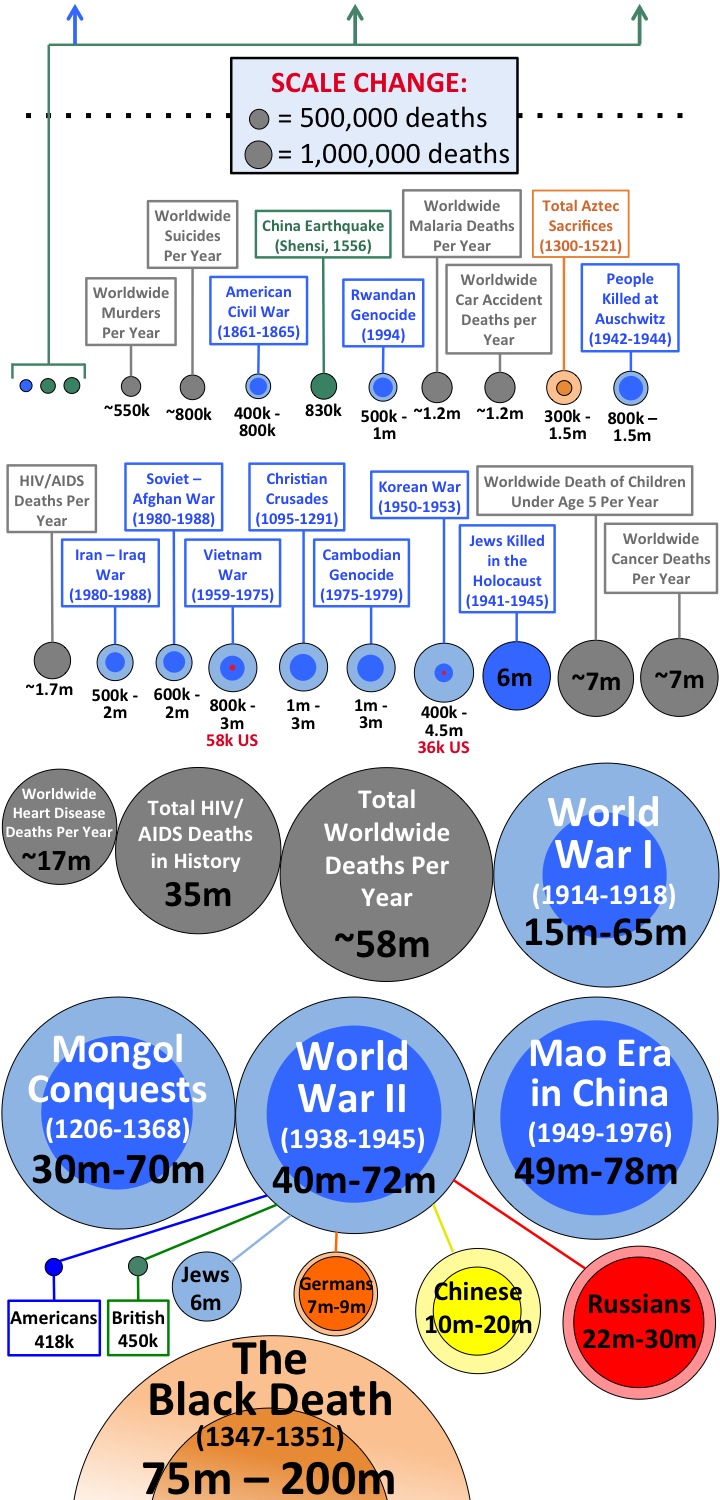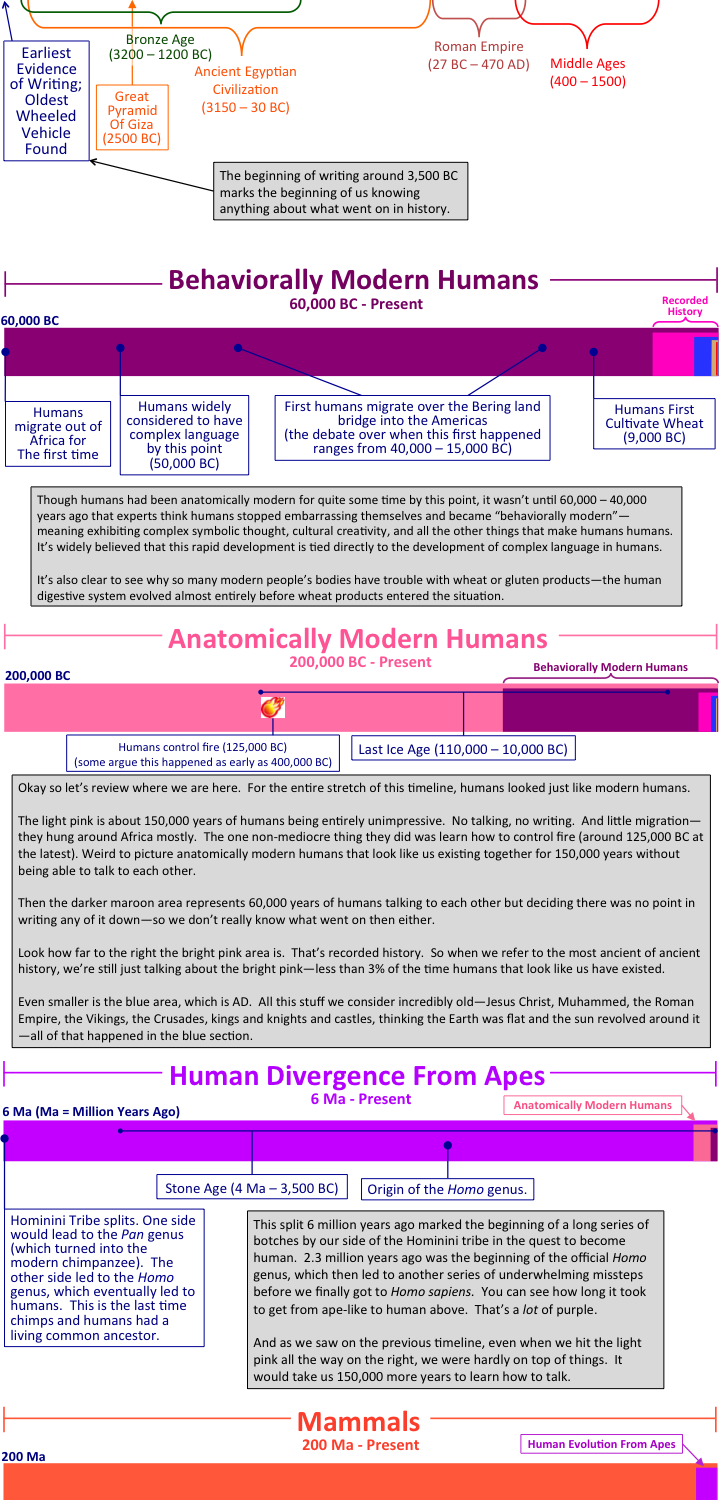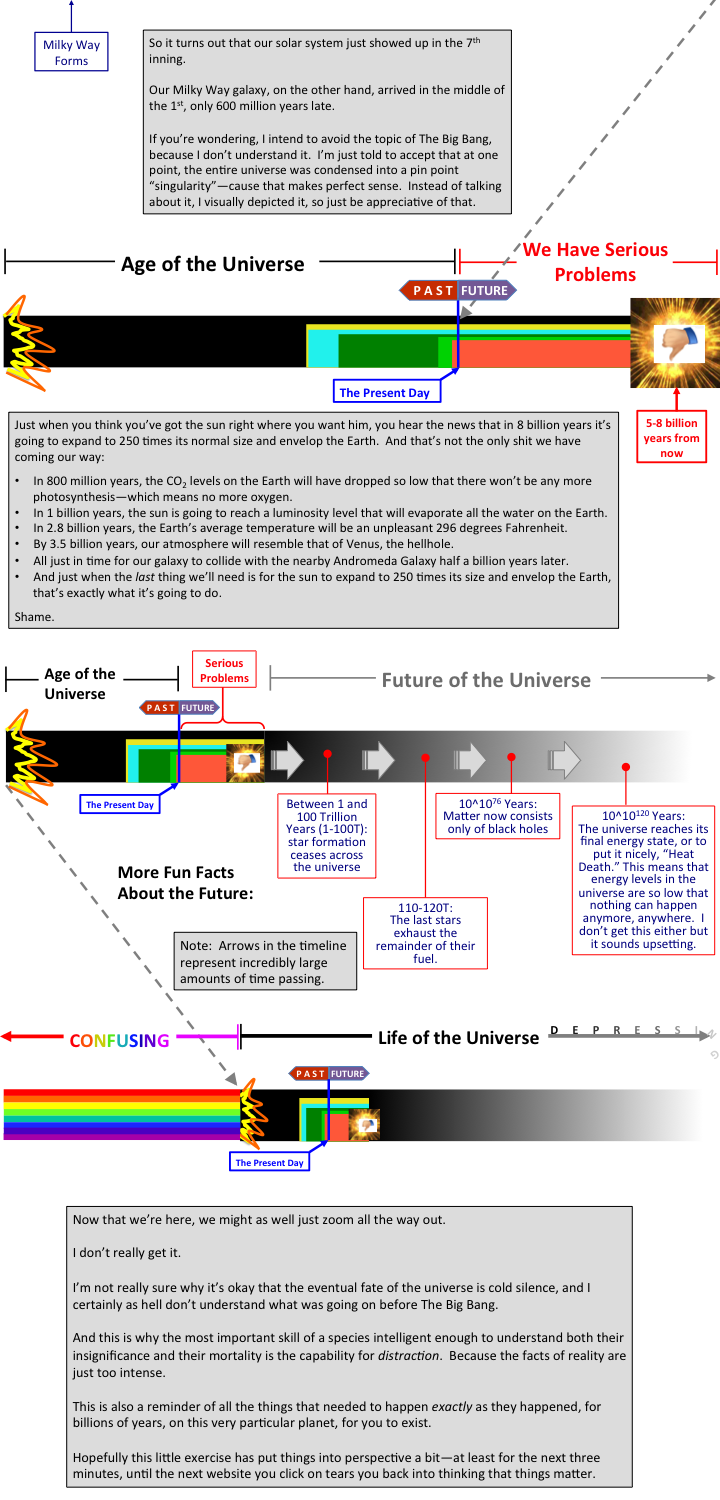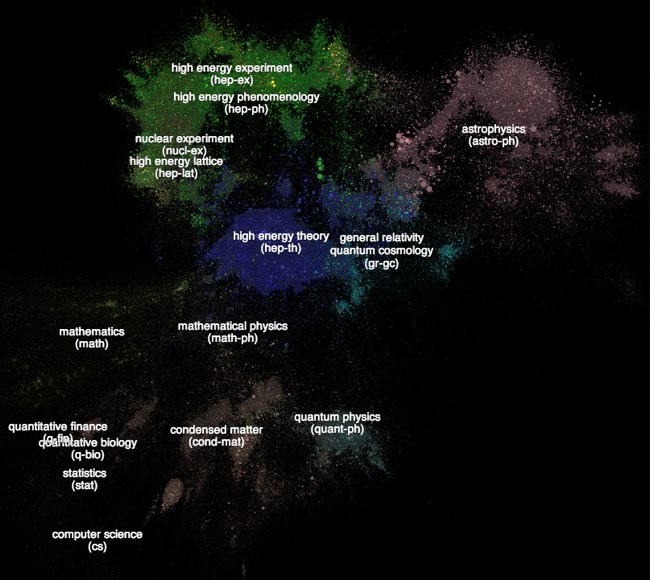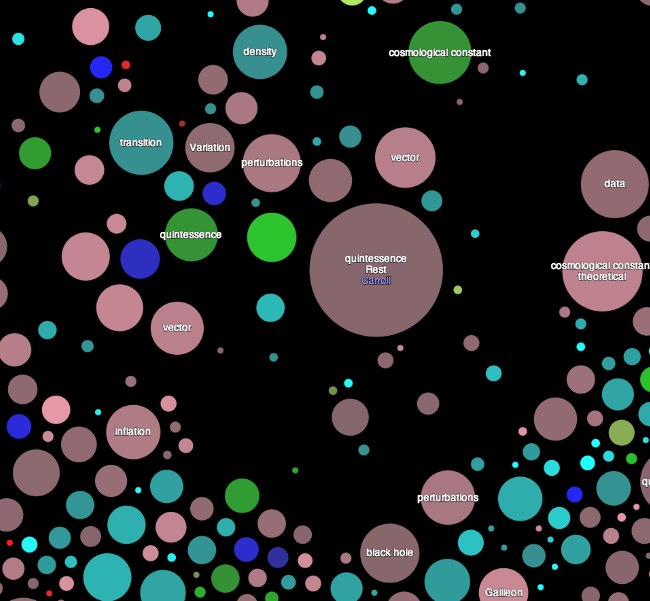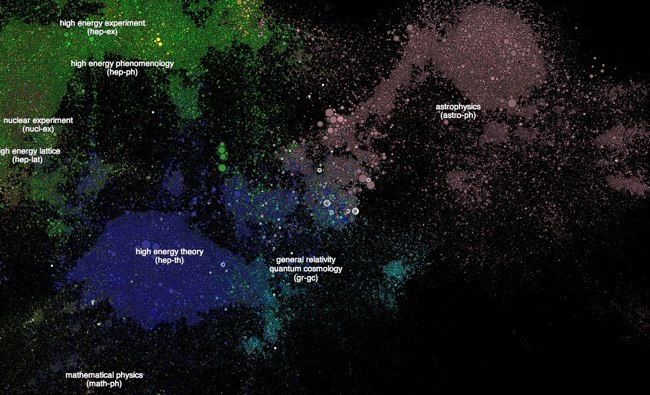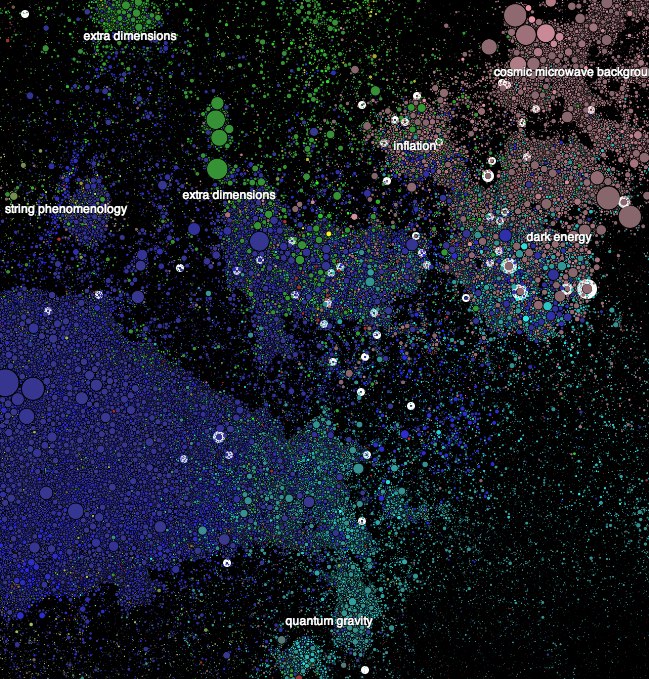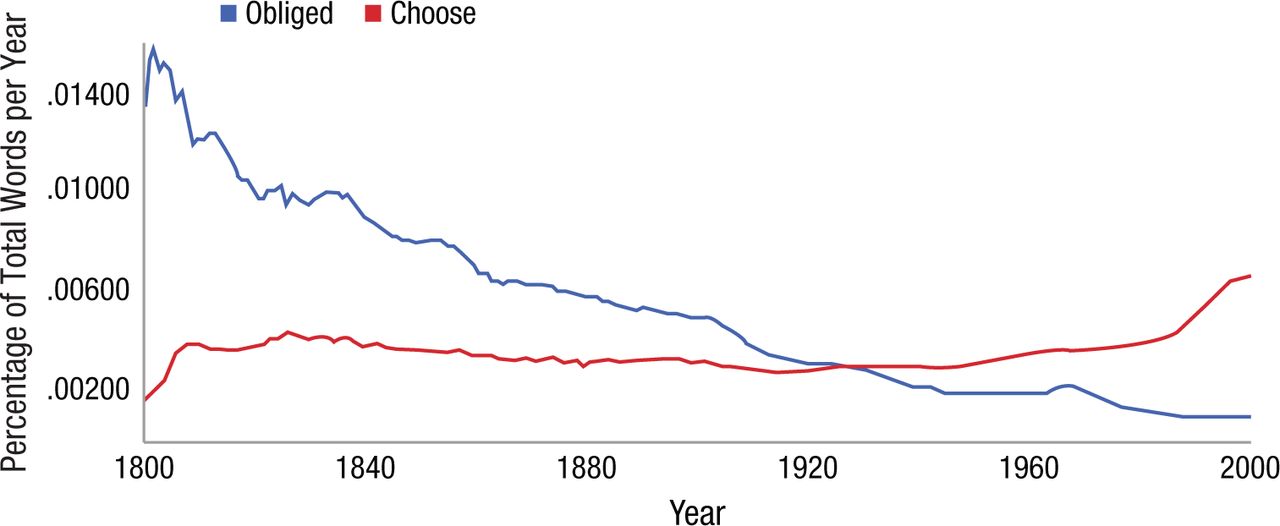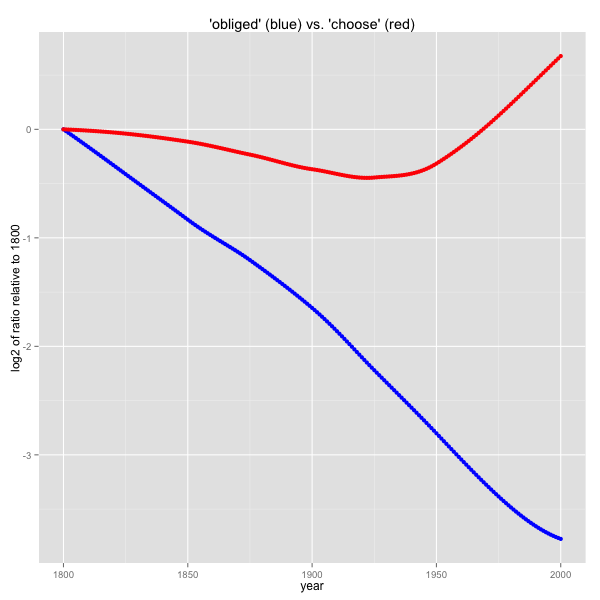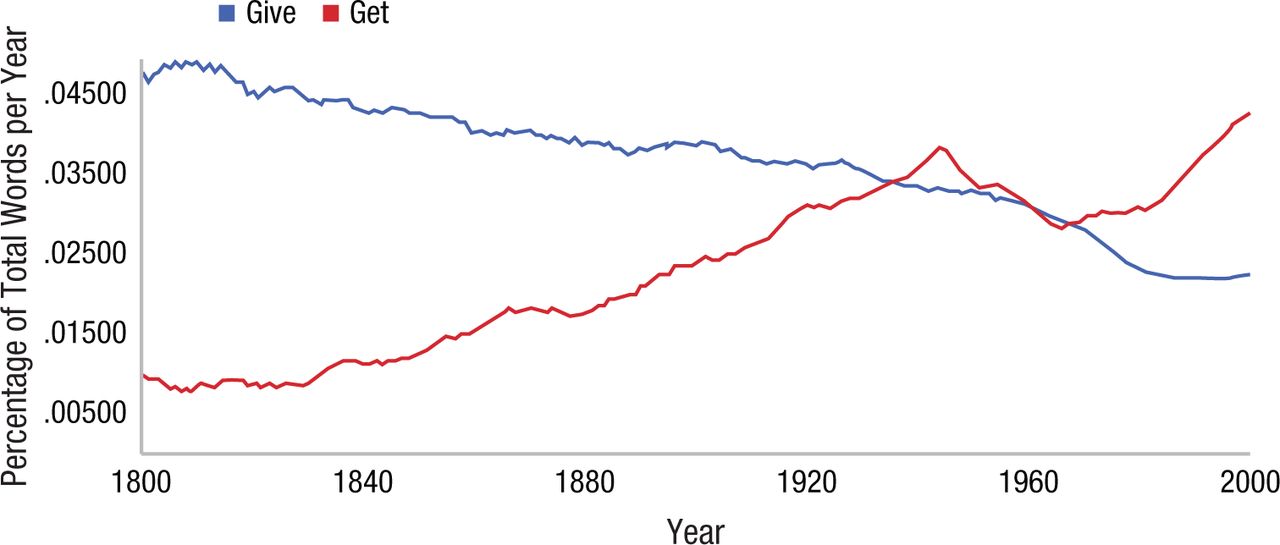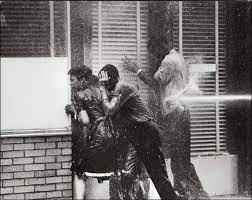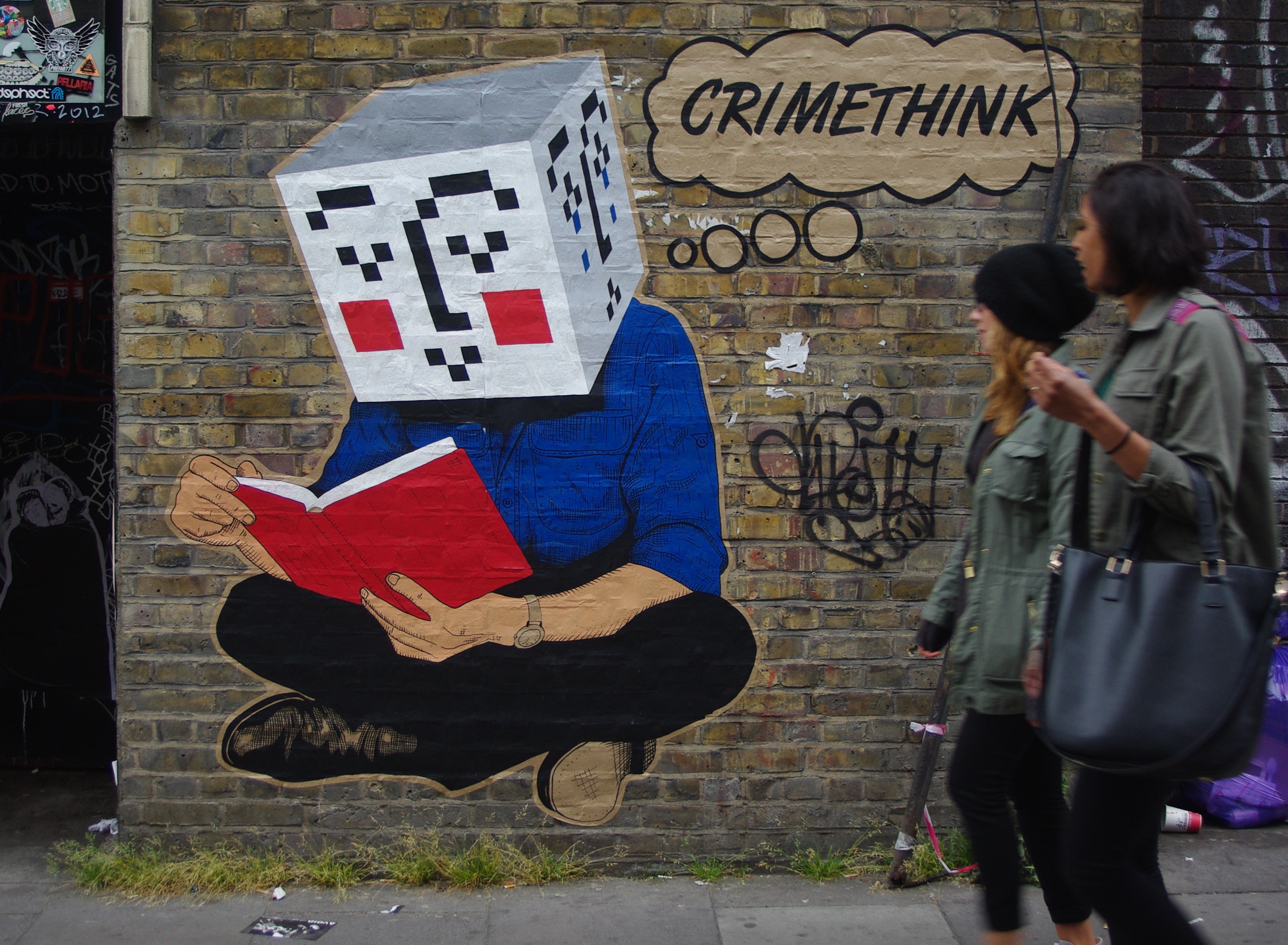Shared posts
"the most important questions facing us"
Wilsonremarkable consensus among academic philosophers in the comments
New Animal and Insect Assemblages Made from Repurposed Objects by Edouard Martinet

Butterfly. 25″ x 14″ x 22″ H. Legs: bike brake parts, pieces of windshield wipers, bike chains. Abdomen: old acetylene light tank. Thorax: car suspension part, small spoon parts, cream chargers. Head: headlights, bike parts. Butterfly trunk: clock springs. Hair: pieces of a typewriter daisy wheel. Antennae: brake cables, drawer knobs.
 Butterfly, detail.
Butterfly, detail.

Butterfly, detail.
 Rhinoceros beetle. 13″ x 11″ x 6″ H. Legs: bike brake parts, bike derailleur chain, bike chain ring. Head and horn: small bike brake, pieces of a typewriter daisy wheel. Antennae: small bike parts. Thorax: shoe tree, bike Luxor headlight. Abdomen: motorbike light, shell-shaped drawer handles.
Rhinoceros beetle. 13″ x 11″ x 6″ H. Legs: bike brake parts, bike derailleur chain, bike chain ring. Head and horn: small bike brake, pieces of a typewriter daisy wheel. Antennae: small bike parts. Thorax: shoe tree, bike Luxor headlight. Abdomen: motorbike light, shell-shaped drawer handles.

Rhinoceros beetle, detail.

Three-spined stickleback. 34″ x 5″ x 13″ H. Body: moped fenders and chain guards. Bones: tablespoons. Gills: car door parts. Fins: cake tins, fish slices, compasses. Tail: motorbike silencer, fish slices. Eyes: flashlights. Head: Solex front fenders.
 Moth. 31″ x 16″ x 7″ H. Wings: moped chain guards (rusted and patinated). Abdomen: motorbike headlights. Thorax: very old car headlamp. Legs: large upholstery tacks, car boot hinges, pieces of windshield wipers, bike brake parts, chain guards. Head: old rear position lamps, bike parts, pieces of a daisy wheel. Butterfly trunk: clock springs. Antennae: aluminium heating resistor.
Moth. 31″ x 16″ x 7″ H. Wings: moped chain guards (rusted and patinated). Abdomen: motorbike headlights. Thorax: very old car headlamp. Legs: large upholstery tacks, car boot hinges, pieces of windshield wipers, bike brake parts, chain guards. Head: old rear position lamps, bike parts, pieces of a daisy wheel. Butterfly trunk: clock springs. Antennae: aluminium heating resistor.
 Moth, detail.
Moth, detail.

Wasp. 11″ x 6″ x 16″ H. Abdomen: steel tips for boots, bike headlights. Thorax and head: steel tips and bells from bikes and typewriters. Eyes: vintage watch case. Antennae: spectacles arms. Legs: bike brakes, bike chain, spoon handles. Wings: glass.

Red ant. 25″ x 16″ x 9″ H. Thorax and head: sauce spoons, car parts. Eyes: marbles. Abdomen: bike or motorbike headlights. Antennae: small bike chains. Legs: cream chargers, brake parts, chains, alarm clock feet, spoon handles.

Dragonfly. 37″ x 49″ x 15″ H. Abdomen: patinated copper/brass bicycle pump, car horn part, parts of old acetylene bike lights (at the ends). Thorax: two motorbike rear lights, shell-shaped drawer handles, big upholstery tacks. Head: car or lorry old stop lights, parts of acetylene bike lights, parts of a daisy wheel for typewriter (hair from the mouth). Legs: tubes, bike cable guide, wing nuts, wire. Wings: umbrella ribs, wire, wire netting for hen coops.

Dragonfly, detail.
When looking at these perfectly assembled sculptures by French artist Edouard Martinet (previously) it’s difficult to believe the raw materials he used ever existed in another form. Yet every head, thorax, leg, wing, and eye from these assorted creatures was once part of a car, bicycle, typewriter, or other found object. Reading through his material lists it becomes clear how completely thorough and judicious Martinet is in selecting the perfect objects to realize his vision, truly a master of his craft. Via Sladmore Contemporary:
His degree of virtuosity is unique: he does not solder or weld parts. His sculptures are screwed together. This gives his forms an extra level of visual richness – but not in a way that merely conveys the dry precision of, say, a watchmaker. There is an X-Factor here, a graceful wit, a re-imagining of the obvious in which a beautifully finished object glows not with perfection, but with character, with new life. Martinet takes about a month to make a sculpture and will often work on two or three pieces at the same time. It took him just four weeks to make his first sculpture and 17 years for his most recent completion!
If you want to see these new pieces up close, Martinet opens a new exhibition at Sladmore Contemporary in London, November 27 through January 31, 2014. You can see several additional new works on his website.
This Insect Has Gears In Its Legs
The image above is an extreme close-up of a common British insect called a planthopper. You’re looking at it from below, at the point where its two hind legs connect to its body. In the middle, you can clearly see that the top of each leg has a row of small teeth, which interlock together. As the planthopper jumps, the teeth ensure that its legs rotate together and extend at the same time.
This insect has gears.
GEARS!
It’s a steampunk bug!
The gears are found on many young planthoppers but Gregory Sutton from the University of Cambridge first discovered them on a common British species called Issus coeleoptratus. “We didn’t have to go to some obscure monastery in Outer Slaubvinia to find these things,” he says. “We had to go to a place called The Garden, in The Backyard. Either the most complicated gearing in nature happens to be in our backyard, or there is stuff that’s vastly more intricate and complicated that hasn’t been found yet.”
Sutton has been working with Malcolm Burrows from the University of Cambridge for the last 10 years, to study the movements of jumping insects like fleas, locusts, leafhoppers and pygmy mole crickets. When they filmed young planthoppers taking off, they saw that the hind legs would always move within 30 microseconds (millionths of a second) of each other. Such extreme coordination makes sense—the slightest difference in timing would send the insects spinning off to the side. But how could they achieve such tightly synchronised movements?
The nervous system can’t be involved. In 30 microseconds, a neuron can barely begin to fire, much less trigger something that tweaks the insect’s movements.
The answer lies on the insect’s undersides. Back in the 1950s, other scientists noted that young planthoppers have small bumps on their trochanters—the first segment of the legs, which connect to the hip-like coxa. They were only found on the hind legs, and not the other pairs. No one knew what they were for. No one seemed to care. “It was one of those odd little footnotes in anatomical books,” says Sutton.
Burrows and Sutton discovered the function of the bumps by planthoppers that had been restrained on their backs. The insects would try to jump whenever the duo gently prodded their abdomens. Just before their legs shot out, their trochanters would squeeze together. The bumps engaged and rolled against each other, exactly like man-made gears. “I was gobsmacked,” says Sutton.
Gears allow two machines to rotate together in opposite directions. That’s exactly what the planthopper’s trochanter bumps do. Sutton tested this by pulling on the tendons of its jumping muscles with some forceps (“It’s the Serious Edition of Operation”, he says.). Even if he only pulled one tendon, both legs would extend because the gears transmitted the motion of one trochanter into the other.
“Then, we got really lucky because we saw a few jumps where the gears wouldn’t engage perfectly,” says Sutton. When this happened, one leg was partially extended before the gears finally snagged and the planthopper’s nigh-perfect coordination was ruined.
Wait! It gets better. These gears are training wheels!
The planthopper nymphs lose them when they become adults. But the adults don’t shoot off in uncoordinated spins—if anything, they’re better jumpers than the youngsters. Their hind trochanters make much closer contact with each other, and Sutton thinks that the friction between them helps to keep them in time. “We’re kind of sure about that, but not entirely sure,” he says.
“This is to our knowledge the first time that proper, engaging, counter-rotating gears have been seen in the animal kingdom,” says Sutton. Crocodiles have cog-like teeth in their heart valves, and the wheel bug and cog-wheel turtle have teeth on their shells. But none of these structures actually act like gears. “You never see one cog-wheel turtle sidle up next to another, engage their shells, and spin in opposite directions,” says Sutton. “If you did, I want you to call me. If I see that on your website, and I haven’t been called, I will be an angry man.”
The discovery is astounding in itself, but Sutton—a mechanical engineer—thinks that they could help us to make more effective machines at incredibly small scales. The teeth of most modern gears harken back to the 18th century, when mathematician Leonhard Euler designed a shape that could be easily cut by a machine. It’s called an involute and it looks like a hill with a plateau at the top. It has been a standard part of gears ever since.
But the planthopper’s gear teeth look more like a shark fin. “What we have is a prototype for a tooth shape for a high-speed, one-directional gear that’s not constrained by the machining techniques of the 18th century,” says Sutton.
Modern machines, such as 3-D printers, could easily create gears with these shark-fin teeth. Sutton is really excited by the prospect, and suspects that they may perform better in very small machines. “Modern machinery often doesn’t work at very small scales,” he says. “Friction doesn’t matter so much when you have two big gears next to each other but when you get small, friction starts killing you.”
The planthoppers might help to solve that problem. “We’re still being impressed and shocked by what we find in the back garden,” says Sutton.
Reference: Burrows & Sutton. 2013. Interacting Gears Synchronize Propulsive Leg Movements in a Jumping Insect. Science http://dx.doi.org/10.1126/science.1240284
More on jumping insects:
The End of Public Space
Wilsonsomewhat long, but interesting read
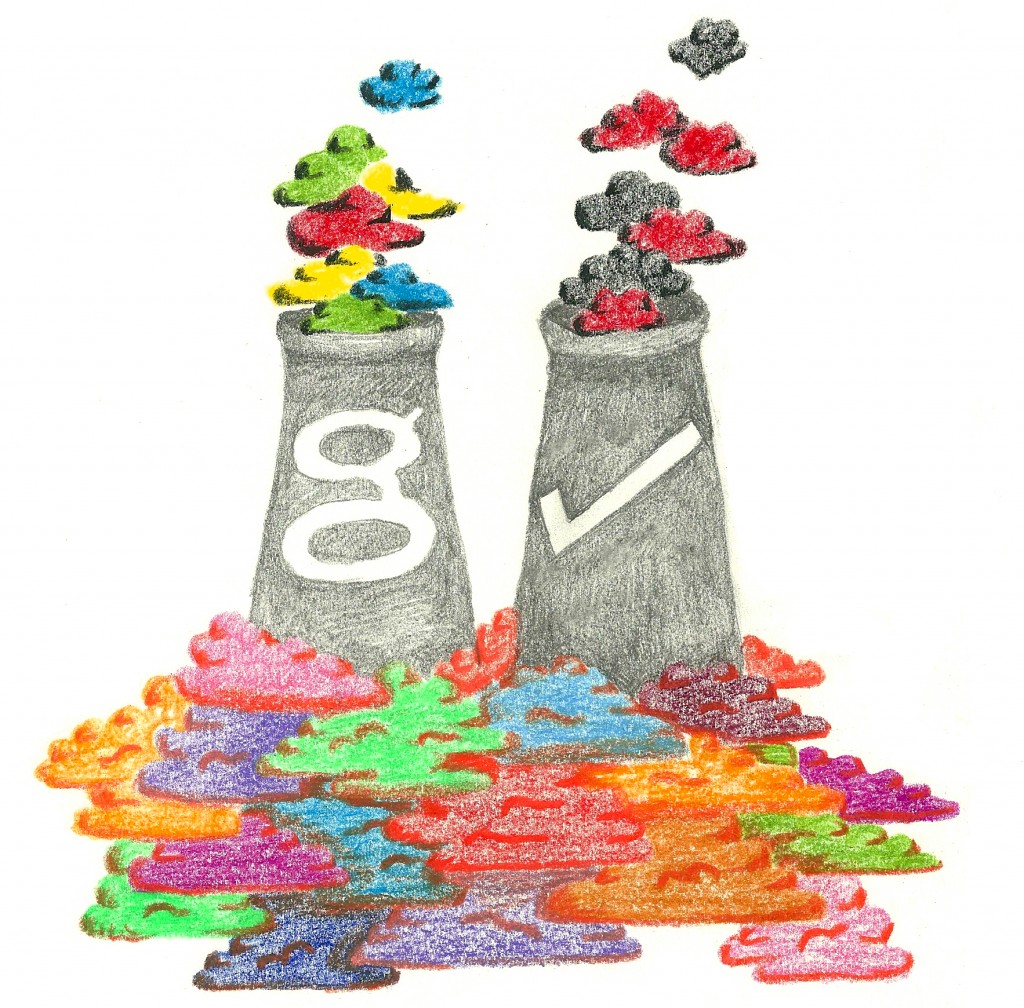 As Americans debate and discuss revelations about the NSA brought on by the Edward Snowden saga — which is not going away anytime soon — it seems that the vast majority of mainstream perspectives focus heavily on the idea of privacy. Various pieces from the New Yorker, The Atlantic and others have discussed the role of the surveillance state and the insidious nature of the President’s “vast eavesdropping apparatus.” The cover of a recent issue of The Nation reads, “The End of Privacy.”
As Americans debate and discuss revelations about the NSA brought on by the Edward Snowden saga — which is not going away anytime soon — it seems that the vast majority of mainstream perspectives focus heavily on the idea of privacy. Various pieces from the New Yorker, The Atlantic and others have discussed the role of the surveillance state and the insidious nature of the President’s “vast eavesdropping apparatus.” The cover of a recent issue of The Nation reads, “The End of Privacy.”
Another popular debate among the mainstream and progressive media questions effectiveness: does the surveillance state work? Does it make us safer, and is it worth the erosion of our civil liberties for ‘security’? People like Glenn Greenwald, David Cole, and Daniel Solove are right when they say the surveillance state is an infringement on our civil liberties, that it doesn’t make us safer, and that it’s not worth sacrificing privacy for security — but this discussion misses a vital aspect of the broader story. Above all, the American surveillance state reflects the ongoing privatization and enclosure of public spaces. It’s certainly important to criticize America’s “surveillance net” in the context of the decline of personal privacy and the loss of civil liberties. But it is also crucial to identify the role of contemporary capitalism in destroying public space and the centrality of public space in making true democracy possible.
****
The initial reactions to Snowden’s leaked information in the media establishment and general opinion polling in its aftermath showed a tacit understanding that telecommunications and the Internet are no longer a true commons. In an interview with Glenn Greenwald, Mika Brzezinski of MSNBC’s Morning Joe was visibly resistant to the idea that anything at all had changed, insisting on legalistic questions structured in defense of authority.
“But is the law broken?” she asked, ignoring the broader moral-ethical character of the issue in a context of warped legalism, where laws can secretly be interpreted and applied. “I don’t think so,” she concluded, “I think we all knew this was happening.” Pew Polling quickly showed a majority of Americans accepting NSA surveillance; larger majorities across all age groups professed to not even be following reports of phone and internet monitoring closely. Apparently contradicting trends in internet usage, younger Americans reported caring considerably less about surveillance than older Americans. Only 12% of Americans ages 18-29 said they followed the news about government tracking of email and online activity, compared to roughly a third of Americans older than 50.
As the weeks progressed — in part thanks to especially vocal (and opportunistic) Congressional opposition in some quarters — Pew recorded subtle shifts in certain features of the general mood. Strikingly, it was the first time more Americans expressed concern over civil liberties abuses than terrorism. Yet a majority still approved of NSA surveillance.
Even if these prevailing attitudes do not concern citizens, they should at least puzzle. We now know for certain that the U.S. government is actively engaging in a project to monitor and archive the entire social internet, a space we once imagined — although not without critical assessment — as free, open and commonly shared as the city square. Mobile phones are now so ubiquitous that for most people cell phone location is practically equivalent to body location. Call content can easily be accessed without warrants in a situation where the Department of Justice “has secretly interpreted surveillance law to permit thousands of low-ranking analysts to eavesdrop on calls.”
Why, then, is there so little resistance? What explains the disengagement of the youth, the complicity of broader society? Looking strictly at the NSA scandal and direct reactions concerning the violation of privacy seems to miss the larger picture. There is in fact a vibrant resistance, and youth engagement with questions of authoritarianism and the commons is deeper than ever before. But to appreciate the true scope of the struggle — and to situate ourselves within it — we need to expand our focus to the cultural and economic forces that enable communications surveillance and the increasingly fragmented society that contextualizes it.
****
How exactly did we get here? In the aftermath of the Cold War, Americans have seen the rise of a remarkable consumer capitalism and seemingly unparalleled material abundance concomitant with historic waves of economic suffering. These odious circumstances are anything but popular or democratic, reproducing themselves primarily through repression. The NSA, however, is just an overt apparatus, sitting astride a much subtler and more insidious regime of social fragmentation that makes it possible.
Advertising and public relations play a key role in our consumer capitalism, bridging the gap between decades of stagnating wages and capital’s inherent need for constant growth in production and consumption. In the context of strict economic rationality, we should not be buying an increasing amount of the increasingly rarefied goods available for purchase (the vast majority of the American population that has seen no real economic gains for a generation). But advertising spending per capita in the United States (consistently the largest ad market in terms of total spending) has increased to $876 dollars for every man, woman, and child — the highest per capita in the world — to urge us to overcome this basic sensibility.
Providing the means to participate in this irrational system has been the boom in easily accessible consumer credit. As late as 1980 the growth for median U.S. household income was on par with that of credit card debt per household. Today, credit card debt is growing at 1,200% the rate of household income.
On the production side of this immense and hollow diversification of commodities are the firms producing these increasingly irrelevant goods. Companies today are exceptionally specialized, from the biotechnology research facility that studies particular strands of the soybean genome to the Silicon Valley startup that lets us chart our sleeping schedules; the cinnamon bun chain store to the mobile phone screen protector industry. Within these environments, the pressures of stagnant incomes and chronic underemployment have pushed Americans to work more than anyone else in the industrialized world.
Pulling these pieces together, a rough sketch of the American worker in the crosshairs of the surveillance state begins to come into focus. The growing irrelevance of the commodities we produce has surrounded us with colleagues we relate to in increasingly fragmented and obscure ways. Combined with the unparalleled magnitude of “work life,” the effect on social life has been withering. The few hours we have left at day’s end, that precious window where finally we might relate to other humans as humans — rather than business partners, employees or employers — are instead largely devoted to reproducing the strength for another day’s work.
One character from The Beautiful and the Damned, Siddhartha Deb’s moving portrait of a rapidly shifting, neoliberalizing India, offers a particularly striking assessment of social life across societies. Chakravarthy “Chak” Prasad is an Indian-born engineer who moves back home from Illinois to enjoy the fruits of uneven development. Deb introduces us to him as he builds a million-dollar house in the newly imported phenomenon of the gated community. In passing observation, Chak astutely outlines what he considers the primary divide between India, what he calls a “high-context” society, and the U.S., a “low-context society.” Reflecting on his time in the States, he observes that American social life is largely appointment-based. People make appointments and keep them; interactions are largely centered around the reason people have been brought together — “low-context.” In “high-context” India (at least the old India quickly fading as the skyscrapers rise), social interactions are less structured, more unplanned and fluid.
These qualitative differences in the texture of social life can be extended across the broader divide between societies that have not yet fully neoliberalized (many in the global South) and the industrialized North. The efficient fragmentation of economic and social interactions carries both unique costs as well as advantages. Under a “Freedom to Choose” low-context regime, what seems distinctly available is choice and personal control over the quality and duration of interactions. A person becomes highly “customizable,” able to pin down with fair certainty the acculturation they will receive. We are generally not subject to the unforeseen impositions of a sociable neighbor or rambling roadside philosopher.
At the same time, important things are lost. A fluidity of being escapes us; life becomes hopelessly transactional. We are anxious about acting inappropriately in particular environments. More problematic is the acting itself. The need to behave in distinct and different ways at work, in school, at yoga class, on a date at the bar, induces a psychosis of constant performance. In airless transitory space — the elevator, the train, the city sidewalks — we are “alone together” in a crowded but lonely world. Yale sociology student Esther Kim observes how in these spaces people exhibit “nonsocial transient behavior,” cultivating an active disengagement from the world around them.
In this light such careful regimentation appears more oppressive than liberating. The idea of social media fits well under these conditions. Reflecting the low-context ethos, social media allows us to carefully perform ourselves online, polishing and customizing the version of ourselves that we present to the world. Tools like Facebook are incredibly useful for managing our appointments and making new ones. Importantly, social media helps us cope with the fragmented state of social relations in a positive way, inserting small, discrete packets of unstructured social time throughout the day. It is not nearly fully satisfactory, but it stands in. The psychosis of performance remains. And relating through the internet erodes the trappings of intimacy, introducing the startling new element of technological surveillance.
*****
In broad terms the surveillance state clearly expresses an authoritarian logic (we must trample your freedom in order to defend against hypothetical wrongdoing), as well as a sexist and racist logic. Falguni A. Sheth states,
I can hear the liberals now: “Of course, there she goes, making it all about race again.” Um, no. The NSA is making it about race/religion/ethnicity – as these are uniquely combined in the conceptual category of “Muslim Terrorists.” Other branches of the state have long established that terrorism is a unique category that, while defined race-neutrally as having to do with international or domestic political violence targeted against the U.S. government or its citizens, is almost uniquely and singularly applied to Muslims. We’ve seen evidence of this at other levels of government, as in the case of the NYPD’s surveillance of Muslims (in New York, Connecticut, Pennsylvania, New Jersey and internationally). Most recently, we saw this with the immediate rush to assume that a Saudi national that fled the Boston bomb blasts must have been the person who set them — before he was cleared the next day.
But it also reflects a fundamentally capitalist logic. Both government surveillance and recent attempts to create a “tiered internet” that would privilege profitable corporations over regular users can be viewed as attempts to enclose upon the social commons.
To illustrate: in his reading of English history, Marx roughly outlines three stages of the development of conditions necessary for capitalist wealth accumulation. First, the enclosure system worked to privatize communal land, turning by royal decree what was “commons,” owned by none and used by all, over to individual private owners. The second phase, the “clearing of the estates,” saw private interests expelling the peasantry from their newly-privatized land, turning the peasants’ means of subsistence into capital’s means of profit, first through the creation of sheep-walks, and then even more profitable “deer parks,” hunting grounds for the idle and wealthy. The final phase of the process was to then transform this nomadized surplus pool of labor into the industrial proletariat through “bloody legislation,” which coerced the landless into wage labor at the threat of incredibly punitive anti-vagrancy laws, effectively “closing their space” to wander.
Today, major corporations like Google and Verizon are pushing federal regulators to abandon the long-held principle of “net neutrality,” which preserves equal access to the Internet regardless of a site owner’s profitability. These firms envision instead a two-tiered system where the well-resourced can pay to have faster connections to their web services. Tiering the internet would closely mirror Marx’s account of enclosure, privileging wealth and power in what was once an egalitarian space. Large chunks of the “land” that was once totally free and open — access to the same internet shared by all — would be closed off for profit-making, expelling the rest of us to the vagrancy of a second-rate internet unless we too turn toward profit.
Government surveillance of the internet appears as a similar attempt to impose property relations on the commons. Just as enclosure destroyed the status of peasant lands in England as true commons, belonging not to the Crown but to the people, justifications of government surveillance rely on the assumption that federal authority can indeed extend to the internet. It is the State, we are told, not the people, that holds ultimate title to the digital commons.
The way in which this authority is exercised lends credence to the claim. Surveillance “keeps us safe,” the State insists, repeating ad nauseum the refrain echoing through Washington since 9/11. “Counterterrorism” as practiced through targeted assassinations and blanket surveillance attempts to preserve the violent conditions of American imperialism (wars of aggression in the Middle East, military and economic support for favorable tyrannical regimes) while eliminating its violent responses, a clear impossibility. While the government outwardly celebrates the shelling of cities as a humanitarian act, it in fact fulfills economic imperatives, ensuring the conditions necessary for profit and resource exploitation.
State surveillance attempts to enroll the entirety of the internet, the entirety of the telecommunications apparatus, toward this grand capitalist project. The programs are not consciously carried out as such, but this is the material global effect they have. Surveillance touches our daily lives primarily as an attempt to stanch terrorism while sustaining the conditions for the bombs to drop, the weapons to ship, the oil to flow and wealth to accumulate.
The same socioeconomic conditions that sustain our increased reliance on communication technologies also inform authoritarian attempts to control their use. But all is not lost. The polling and reporting on recent NSA revelations obscure the true extent of the struggle against authoritarianism and capitalist enclosure more generally by honing in on an infinitesimal pinpoint of the issue. Zooming out and appreciating the brutal economic and social factors feeding the logic of the program is a much more fruitful exercise. This is what various points of global resistance have intuitively done and continue to do. Viewed in scope, it seems myopic to rally around a specific surveillance program carried out by a specific state apparatus when their noxious economic and social foundations remain unaddressed.
So it is not surprising to take a step back and see people all over the world gathering in the commons they refuse to relinquish, from Zuccotti to Tahrir to Syntagma to Gezi. Those who resist are aided by tools on the internet freely available and commonly used, despite attempts to systematically narrow and control these avenues. These popular uprisings against authoritarianism are taking root in no more apposite a place than the public square, finding voice in the outrage against attempts to enclose common space, common economic growth, our common climate.
It is this struggle that we should emphasize, and in doing so shift our focus from the private sphere to the public sphere. Liberals berating Obama and his surveillance program in the context of the invasion of privacy – and for larger reasons connecting privacy, democracy and political freedom – are missing the bigger picture. We should be equally, if not more, concerned with the disappearance of the public sphere as a space of democratization.
****
Concepts of insurgent citizenship and constituent movements may help better appreciate the democratic value inherent to public space. Studying the years immediately after the American Revolution, political theorist Jason Frank presents useful ideas concerning times of democratic opening throughout history. The specific period he focuses on in the United States, the late 18th century, shows many of the characteristics of what Frank calls a constituent moment, that is, a moment when the “underauthorized seize the mantle of authorization.” Claims to speak of/for the people are well suited at such times, and they generate a political movement even though they break from the established channels of representing the popular voice.
Post-revolutionary America was a place of vibrant protest that constantly promoted the idea that ordinary people should be in charge of the political arena, not just the landowning elites. As Gordon Wood observes, “the American people came to rely more and more on their ability to organize themselves and to act out-of-doors, whether as mobs, political clubs, or as conventions.” Frank clarifies how “out-of-doors” came to encompass not only the street or the public squares but also communal activity taken outside of conventional political channels: “committees, conventions, popular juries and crowds…attempted to gather power from outside the political system; they were quasi-legal institutions that allowed the people to emerge and that made ‘possible a new actor collective in nature.’” Importantly, as David Graeber reminds us, these new forms of democratic organization developed in close contact with cultures traditionally communitarian and nonhierarchical in nature, such as Native American tribes and the pirate ships of the Atlantic. It is vital to note that the democratic space-creation that Frank describes occurred in the context of a historical settler colonial project and massive violence.
Frank shows how revolutionary crowds and democratic clubs created spaces of insurgent citizenship that allowed people to act without institutional authorization. Fundamental to this type of citizenship, he emphasizes, are political actions that lie outside of the traditional political realm. It requires “spaces of political declamation as well as political deliberation,” which in turn help “create an assertive and oppositional public culture.” In America’s post-revolutionary context, this oppositional public culture was pivotal in transforming public sentiment, shifting the debate toward a more popular and populist republicanism.
John Friedmann refines this idea of insurgent citizenship:
Insurgent citizenship is self-declared and voluntary. This is what defines it as being “from below,” that is, from the classes of commoners… Insurgent citizenship is achieved through active participation in temporary, nonterritorial political communities engaged in a dual struggle: the defense and preservation of exist in human and citizen rights and the claiming of new rights… To be an insurgent citizen is to be active in projects that, in the broadest sense, are aimed at the expansion of the spaces of democracy.
Many other authors have offered conceptions of insurgent citizenship that align with Frank’s ideas. Linda Zerilli describes an Arendtian, “action-centered” conception of politics, citing “coffee houses, street corners, living rooms, and kitchens” as exemplifying “how any physical space can be transformed into a political one and indeed how it is that things become public.” The work of anthropologist James Holston also focuses on spaces of insurgent citizenship: “By insurgent, I mean to emphasize the opposition of these spaces of citizenship to the modernist spaces that physically dominate so many cities today… The spaces of an insurgent citizenship constitute new metropolitan forms of the social not yet liquidated by or absorbed into the old. As such, they embody possible alternative futures.”
It should be noted – and this is an essential point – that the aforementioned characteristics of insurgent citizenship and the politicization of public space are vividly recognizable in the protests in Turkey and Egypt today. Cemal Burak Tansel observes that, in the case of Turkey, while the protection of green spaces such as Istanbul’s Gezi Park is necessary, the rapid growth of the movement against the Turkish government signifies deeper dissatisfaction with a larger political program the AKP has pushed since 2002: “authoritarian neoliberalism.” Tansel writes:
[P]rivatisation and the closure of public spaces continues as an increasing number of symbolic venues have become targets of the new construction boom… The planned urban restructuring of Taksim and the destruction of Gezi Park has to be understood in the context of state-driven privatisation projects which fulfill the double enactment of surplus absorption and the closure of public spaces.
Along this line of thought, Sarah El-Kazaz argues explicitly “this is about the park,” and by focusing on the movement of the defense of the right to the city we have an opportunity to pinpoint the structural weaknesses of the Turkish regime. She claims, “The right to the city stands at the core of the political. The ability of people to decide the fate of their city, use their spaces as best fits their daily and expressive needs, feel secure in their property and receive essential services are at the heart of the relations that bind a citizenry to its government.”
In Egypt, Sharif Abdel Kouddous stressed as early as 2011 how public space in downtown Cairo had become the primary battleground in the effort to oust Mubarak. And just in the past few weeks, Kouddous noted how protesters filling Tahrir and other squares around Egypt used public space to air their grievances against Morsi.
In a much-discussed paradox, it is precisely this democratic insurgency of people in claiming their city that constitutes the sovereignty that governments cite while destroying public space. In the U.S., for example, acts of state repression are justified in legalistic terms that derive their legitimacy from the Constitution. What legitimizes this document in turn are “the people” who historically engaged in illegal acts of revolutionary violence. Appeals to legal authority collapse under the weight of this contradiction. Laws wielded as weapons against the commons again show themselves to be exercises of sheer brute force. Encampments are raided under the guise of making the spaces available for “the public.”
****
We should be thankful for the light Edward Snowden has shone on the American surveillance state, because with each new story the ugliness of its true scale becomes a little clearer. Taking a step back, it becomes clear that state surveillance is only a symptom of a much deeper disease. To focus simply on its immediate costs – deterioration of privacy, tactical inefficacy – is not enough. The destruction of the commons and the privatization of public space is an equal, if not much more serious, danger. As the concept of insurgent citizenship helps illustrate, these are the vital areas where democracy actually happens, where popular sovereignty takes root.
The NSA’s spying program is a single flashpoint amid the interconnected patterns of social fragmentation, economic inequality and political control that govern our lives. This broader cultural and economic perspective is crucial in understanding the full role surveillance plays in society. Our creeping loss of the commons indicates a much graver shift in social relations than the strictly individualist perspective suggests. Both personal and collective agency are stifled when the few powerful seize the spaces where we can think and reason and express our dissatisfaction, individual freedoms that collectively make mass democracy possible.
Prashanth Kamalakanthan writes on race, US foreign policy and political economy. He lives in Durham, North Carolina, and can be followed @pkinbrief.
Daniel LoPreto is Assistant Editor at Nation Books. He resides in Brooklyn.
Illustration by Eliza Koch. See more of Eliza’s work here.
Ancient Printing Rituals Form Intricate Sand Patterns

Sand Prints is a series of ephemeral art created by environmental artist Ahmad Nadalian. Each site-specific piece is a small sculpture naturally blended into a beach or desert landscape. The sculptures become a part of the surrounding land and provide viewers with the opportunity to explore, touch, and even disrupt the final images.
In all of his work, the artist redefines ancient rituals and symbols in contemporary ways. This project is inspired by an ancient printing technique that used carved cylinders to create repeating patterns. Nadalian's modern-day carvings include living creatures like fish, snakes, and crabs, as well as floral patterns that he rolls along the surface of the sand to produce the long rows of repetitive illustrations.
The beauty of each piece is that the loose earth can hold the designs for only so long before the wind disrupts the arrangement or the tide washes it away. Through this fleeting process, Nadalian believes he is making an offering to the Earth, hoping to heal the spirit of our neglected environment. He says, "Art offers a blessing and hope for harmony with the past, with the earth, and the heavens."
Faces From Gitmo

Molly Crabapple, Samir Moqbel (detail), 2013.
America wants to forget about Gitmo.
Sure, we gloat about Khalid Sheikh Mohammed. When I visited Guantanamo in June to cover the 9/11 military commissions for VICE, I drew him through three layers of bulletproof glass. Khalid Sheikh Mohammed is a mass murderer, and we caught him. U-S-A Number One.
But KSM-style terrorists are rare at Gitmo. Out of the 164 men held in the island prison, the chief prosecutor at Guantanamo Military Commissions, Brigadier General Mark Martins, told me that 144 would never be charged with any crime.
They are to be held until the end of the “War on Terror.” But wars on concepts seldom end.
During the invasion of Afghanistan, the United States offered locals $5,000 bounties for turning in terrorists. Instead, we got a mixture of Taliban draftees, guys who shot rifles at Islamic training camps in the 1990s, Uighurs fighting China and, above all, Arabs in the wrong place at the wrong time.
Now, branded by Bush as “The Worst of the Worst” they are to be held until the end of the “War on Terror.” But wars on concepts seldom end.
Of the 144 men who will never be charged, 84 have been cleared to leave for years. But they live in a Kafkaesque legal limbo. In what a Guantanamo spokesman claimed was a concession to the Geneva Conventions, they’re banned from speaking to press.
As of September 2, 35 prisoners are on hunger strike. Thirty-two are being force-fed, a brutal process that involves Ensure being pumped through a tube snaked into their stomachs.
One night, I drank beer with a press officer at Guantanamo’s jerk chicken joint. She described herself as a pacifist in camo. As she spoke about the hunger strike, her tanned, pretty face drew tight. “I don’t know if they’re innocent. I don’t know if they’re guilty,” she told me. “I don’t even know their fucking names.”
Americans see
bogeymen in orange jumpsuits—not men with PTSD, favorite
soccer teams and back problems…
This is by design. Guantanamo’s guards refer to prisoners by numbers rather than names, and are banned from reading their Joint-Task-Force Guantanamo detainee assessments, which WikiLeaks made public. The U.S. government refused to release prisoners’ names until 2006. When I returned to Cuba in August to write a follow-up article for VICE, I visited the prisons for the first time, but I was not allowed to draw detainees’ faces. Americans see bogeymen in orange jumpsuits—not men with PTSD, favorite soccer teams and back problems; families and dreams; loves and legitimate hates.
For a journalist, trying to piece together the life of a Guantanamo detainee involves staring into the bureaucratic unknown. You have JTF-GTMO assessments, filled with feverish claims and torture-induced accusations. (One former detainee, Binyam Mohamed, comes up repeatedly as a source of accusations against fellow prisoners – accusations he made during C.I.A. rendition in Morocco, while interrogators allegedly sliced his genitals with razors. The U.K. government awarded him a million pounds in damages for their role in his torture.) You have their lawyers. If you’re lucky, you have blacked-out intelligence reports. Thanks to a Freedom of Information suit filed by Miami Herald journalist Carol Rosenberg, you know the names of the indefinite detainees.
But why some are approved to leave while others will be held as long as the prison exists? That’s hidden behind a wall of classification.
Since media are not allowed to photograph prisoners at Guantanamo, the only recent images come from photos taken by the Red Cross. The British legal charity Reprieve shared these photos of seven of their clients. Each of these men has been cleared years ago to leave Guantanamo. None has been charged with any crime. Here are their names, faces and, as best I could figure out, their stories.
Shaker Aamer

Molly Crabapple, Shaker Aamer, 2013.
Guantanamo press officers hate Shaker Aamer. Though they are not supposed to speak about individual detainees, they roll their eyes at his complaints of abuse. Believing anything Aamer says, they seem to hint, is for chumps.
Aamer, a Saudi-born British resident who worked as a translator for the U.S. army during the first Gulf War, is married to a British woman. On February 14, 2002, the day Aamer was transferred to Guantanamo, the youngest of his five children was born. Aamer has never met his son.
Aamer is also Guantanamo’s most vocal detainee. As organizer of hunger strikes, he writes scathing editorials for the Guardian. He is a cause celebre in Britain.
Ramzi Kassem, Aamer’s U.S. attorney and a law professor at the City University of New York, told me, “Shaker believes that only through constant civil disobedience and peaceful protest can he retain and assert his dignity and autonomy as a human being imprisoned at Guantanamo.”
“I sometimes feel sorry for these young prison guards at GTMO,” Aamer told Kassem. “They have been trained not to be kind, even where their instincts tell them to be kind. They have been told lies and absurdities about the prisoners to the point that they are shocked that I can speak English and they are still in disbelief that I know bands like AC/DC and that I listened to that band before the guards were even born.
“The guards check the soles of prisoners’ shoes as part of their body search protocol. They ask me to lift up my shoes behind me while I am standing up, like a mule. I have rejected this procedure for years. Instead, I insist on being brought a seat, I sit down, then I stretch out my foot and make the guard get down to the ground on his knees to check the soles.”
Samir Moqbel

Molly Crabapple, Samir Moqbel, 2013.
Samir Moqbel got his first job at a factory in Yemen at the age of 12. According to his JTF-GTMO assessment, he practiced rifle shooting for four afternoons in 2000, before splitting to Afghanistan to fight the Northern Alliance (a year before we declared war on the Taliban). Because of these allegations, the United States has imprisoned him for 11 years, at the cost of over $11 million.
Moqbel’s lawyers at Reprieve tell a different story. A friend lured him to Afghanistan with promises of better-paying work, and then, when none materialized, tried to convince him to join the Taliban. He was arrested at the Pakistani border, while asking the Yemeni Consulate with help for his lost passport.
Moqbel has been on a hunger strike since March, and is one of the 32 men currently being force-fed. In an editorial in the New York Times, he wrote: “It was so painful that I begged them to stop feeding me. The nurse refused to stop feeding me. As they were finishing, some of the “food” spilled on my clothes. I asked them to change my clothes, but the guard refused to allow me to hold on to this last shred of my dignity.”
In June, I asked Guantanamo spokesperson Captain Robert Durand about Moqbel’s editorial. “Most of what they say short of ‘I don’t want to be here’ is patently false,” he replied.
Twice a day, soldiers shackle Moqbel to a restraint chair, and force a feeding tube into his stomach though his nose. They then pump Ensure through the tube. According to Guantanamo spokesman Lt. Col. Todd Breasseale, as of June he could choose his flavor: vanilla, strawberry or butter pecan.
Nabil Hadjarab
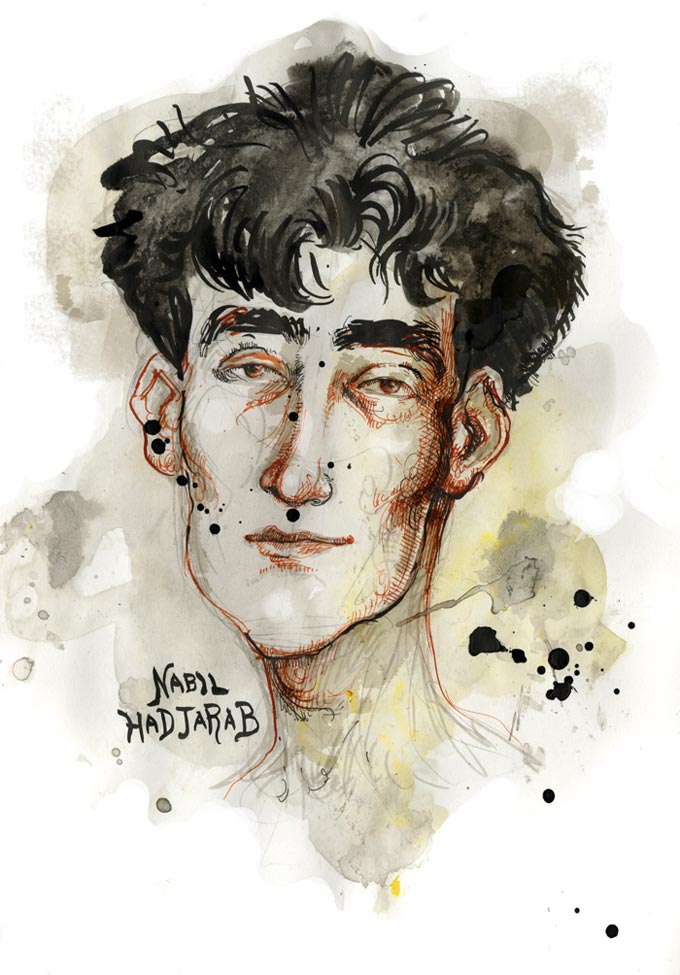
Molly Crabapple, Nabil Hadjarab, 2013.
Nabil Hadjarab’s life was shaped by colonialism’s absurdities. Born to an Algerian father who fought on the side of the French, Nabil came to Paris as an infant. While his siblings are all French citizens (one of them even earning a National Medal of Honor in the French army), Hadjarab’s Algerian birth meant French citizenship was anything but assured. On the advice of an immigration lawyer, he left France for England while his residency papers were being processed. Going broke working off the books, Nabil listened to a friend who told him that in Afghanistan, papers were superfluous. Two months later, American bombs hit Kabul.
Like 86 percent of those at Gitmo, Hadjareb was sold for a bounty by Afghans who had every financial incentive to say he was a terrorist. For the next eleven years, he cooperated with U.S. authorities, learned fluent English, worked out and kept his mind on the world beyond Guantanamo’s Camp Delta walls.
In February 2008, the Department of Defense emailed Hadjarab’s council: “Your client has been approved to leave Guantanamo…. As you know, such a decision does not equate to a determination that your client is not an enemy combatant, nor is it a determination that he does not pose a threat to the United States… I cannot provide you any information regarding when your client may be leaving Guantanamo.”
On August 29, the Pentagon announced that Hadjarab had been repatriated to Algeria. Because of travel restrictions, he will likely be unable to return to his family in France.
Hisham Sliti
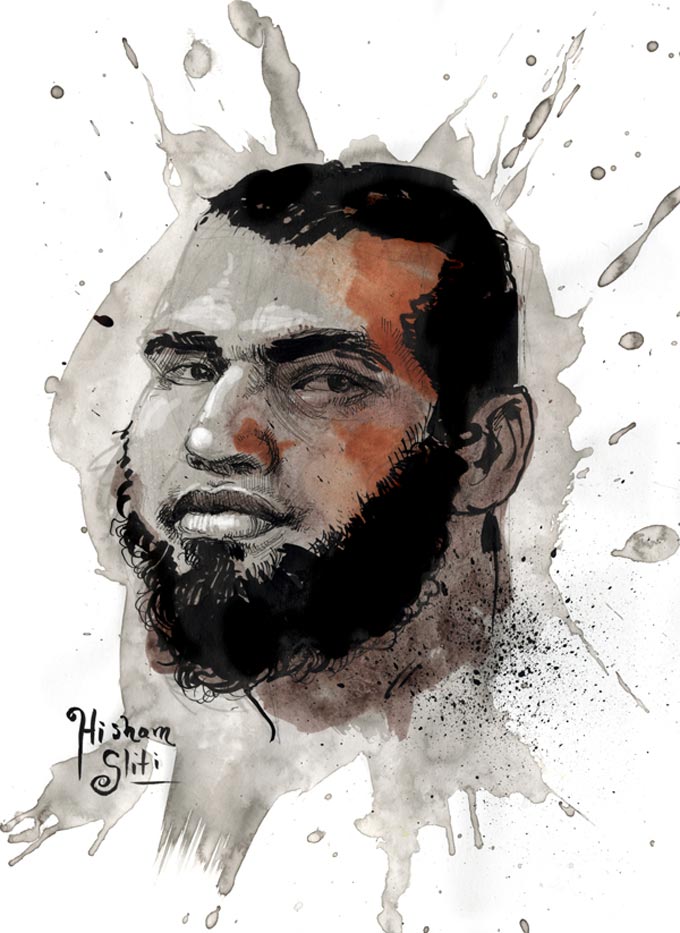
Molly Crabapple, Hisham Sliti, 2013.
When Reprieve lawyer Cori Crider first met Hisham Sliti, she wore a hijab out of respect for his religion. “Why are you wearing that?” he laughed. “You don’t need that here. It’s hot!” Born in Tunis, Sliti moved to Italy looking for work, as many young North Africans do. According to Crider, he spent half her first visit talking about how much he missed Italian women. In Italy, Crider told me, Sliti became addicted to heroin. After a few arrests, a conservative Belgian cousin shipped him off to Afghanistan, so he could kick his habit and get in touch with God. Sliti despised it. Detoxing cold turkey in a sweltering country where everything from sex to cigarettes was forbidden pushed Sliti toward homelessness. Then, America blanketed Afghanistan with flyers offering $5000 bounties for Arabs.
On August 16, 2006, a lead inspector from the Belgian Federal Police told the Department of Defense that Belgium’s investigation of Sliti did not disclose any acts of terrorism. He was just a “Jalalabad junkie.”
Sliti is clean now. “He’s seen the bottom of it all, but is very jovial,” Crider told me. “He gets himself into trouble when he sees people mistreated.”
Sliti has been imprisoned since December 2001.
Adel Hakimi

Molly Crabapple, Adel Hakimi, 2013.
In a former life, Hakimi worked as a hotel chef in Bologna. Now, he only smiles when dreaming about setting up a snack stall back in his native Tunis. According to Crider, who represents Hakimi, he “went through some things in Kandahar from which I don’t know if he will ever recover.” By this she means kicks to the head.
Leaving Bologna would set Hakimi on a collision course with the War on Terror. Hakimi claims to have been looking for a Muslim bride in Pakistan. He married an Afghan women, and his new in-laws demanded he move with them to their native Jalalabad. They spoke about opening a restaurant. Hakimi would be the chef.
Hakimi’s wife was pregnant during the American invasion. Before she could give birth to their daughter, Hakimi was kidnapped by bounty hunters.
Hakimi’s JTF-GTMO assessment claims he shot guns at the Khalden training camp three years before the towers came down, ran a guesthouse for Tunisians in Jalalabad and was an advisor to Bin Laden. They further allege he blamed 9/11 on “the aggressive and tyrannical acts of the U.S. and its support of dictators,” and once refused to pass his food tray back to a guard.
When I asked Hina Shamsi, director of the ACLU’s National Security Project, how the public should regard JTF-GTMO assessments, she told me “These are one-sided assessments that are full of uncorroborated information, information obtained through torture, speculation, errors, and allegations that have demonstrably been proven false.”
In 2012, The Guardian filmed Hakimi’s brother Emad in Tunisia. “He caused no harm to anybody,” Emad said, holding a photo of Hakimi’s daughter, Hind. She grinned in her pink sweatshirt. “We pray to God that he will meet her soon,” said Emad, “and hug her just as any father hugs his child.”
Younous Chekkouri

Molly Crabapple, Younous Chekkouri, 2013.
Born in Morocco, according to Crider, Chekkouri travelled throughout the Islamic world doing relief work. When his younger brother Radwan couldn’t get a job, Younous suggested he join him in Jalalabad. Then, the war started. Wounded by U.S. bombs, Radwan was captured by The United Islamic Front for the Salvation of Afghanistan, and sold for a bounty from his hospital bed. Younous was later captured by the Pakistanis. The two brothers found themselves together in Gitmo. Crider tells me that Younous confessed to wild charges to deflect attention from his brother, who was released from Gitmo in 2004.
In his JTF GTMO assessment, unnamed sources claimed Chekkouri co-founded the Moroccan Islamic Combatant Group (a terrorist group connected to the 2004 Madrid subway bombings) and met Bin Laden. To the JTF, his denial only confirms his guilt. According to Crider, Chekkouri is racked with remorse for suggesting his brother join him in Afghanistan. His first question to Crider during her last visit was, “How is Radwan?”
Ahmed Belbacha

Molly Crabapple, Ahmed Belbacha, 2013.
A former civil servant, Belbacha fled his native Algeria after receiving death threats from the fundamentalist guerrillas of the Groupe Islamique Armée. He settled in England, where he worked as a cleaner. Belbacha once cleaned the rooms of Deputy Prime Minister John Prescott. He got a nice tip. But Belbacha’s asylum application was turned down and, fearing deportation, he left for Pakistan and then Afghanistan. When war hit, he was captured trying escape back into Pakistan.
Cleared for release since 2007, Belbacha was sentenced to a 20-year-prison sentence in Algeria, seemingly for talking slag about the regime. Unable to return home, and with no other countries willing to take him, Belbacha is trapped in Guantanamo. He has been hunger striking since February.
In October 2007, the United States declined Belbacha’s asylum request, sent from Guantanamo’s Camp Delta. The letter states that asylum requests must be filed on U.S. soil.
This piece, commissioned by Creative Time Reports, has also been published by The Daily Beast.
The post Faces From Gitmo appeared first on Creative Time Reports.
The Death Toll Comparison Breakdown
Tweet
Like this post on Facebook:
Like Wait But Why on Facebook:
Putting Time In Perspective
Tweet
Like this post on Facebook:
Bike-powered Elevator to Treehouse
The New Nietzscheans
Ah, Nietzsche. The first and last resort of disaffected males in their late teens—of the type that keeps such an ironic detachment from life as to refer to men and women as “males” and “females.” They read about The Philosopher and The Overman and The Antichrist and self-flatteringly assume that he’s talking about them. So God isn’t Great after all! So those things we call “manners” are actually vices; morality is an ancient and useless ghost from the Levant, one that has colonized our sadistic superegos and turned them against us! They rush to their keyboards, informing fellow travelers in r/atheism about their discovery. We might indulge their bright-eyed enthusiasm and forgive them for never getting to the passages where Darwin appears as a villain and—what is worse to Nietzsche—a plodding and pedantic bore.
Why do I now relive the combination of admiration and revulsion I felt when I first read Nietzsche? Well, a gentleman by the name of weedguy420boner introduced me to this:
Cyber-dystopia, meet your new official philosopher.
Society has for many years showered the computer-literate with special favors. We have in wholesale fashion displaced our old stereotypes about scientists—heroic men and women, living as ascetics, grasping towards new truths without fear of the consequences—onto coders, social media gurus, and the venture capitalists who enable them. We have thought their characters’ more chivalrous those of other subcultural votaries. (They’re not in some cases, as a Google News query for “Penny Arcade” would reveal). We have treated their cultural products as somehow embodying a greater authenticity than whatever we might categorize under the dread rubric “mainstream.” The Revenge of the Nerds franchise has aged worse than other cinematic classics—yes, even the hammy and ham-fisted On the Waterfront—because the idea that programmers are eo ispo persecuted outcasts has no basis in sociological fact.
We’ve reaped the consequences in the form of Silicon Valley Nietzscheans, digital Leopolds and Loebs. The visionaries behind Candy Crush and the rest of the app-based grab bag now feel so above hoi polloi that finding new ways of taking their money is not so much an exercise in business strategy—which is as it should be—as it is a deeply expressive release. Nietzsche tells us that creative power is a value higher than truth—“the will to truth” of so many Enlightenment milquetoasts was nothing but the covert discharge of the impulse to dominate, the will to power—and such power comes from recognition. It is not enough that I think that I’m noble and that my creative output is great, but others must think so as well. These ideas are narcotic to people who, like me, earn a living through the manipulation of abstract symbols; Nietzsche offers our ever-insecure selves a way to constitute our identity through others’ groveling before out “creative genius,” even—or, rather, especially—as we treat these others with contempt.
Nietzsche in fact hated the capitalism and its entrepreneurial avatars for all the unusual reasons. It wasn’t objectionable as an engine of exploitation or inequality or social disruption. (In fact, in one of the few passages that directly addresses politics, he presciently writes without rancor that in the future private actors will assume responsibility for even the most public forms of human activity, like war). It was objectionable rather because the elites it produces are wholly unlike the Greek aristocracy that sired Aristotle. He accused them of being uncurious and uncourageous “last men,” addicted to comfort and material plenty, inferior to even the devout farmer because they treat nothing with reverence and touch everything with their unwashed hands—guilty above all of “the introduction of parliamentary imbecility, including the obligation of everyone to read his newspaper at breakfast.” Abolishing suffering, which the liberals and socialists of Nietzsche’s day earnestly championed, held out not the promise of a New Jerusalem, but rather the threat of a hedonistic commonwealth in which art is impossible and Farmville is the primary obsession.
(An aside: it is unclear if Nietzsche deliberately tinged this portrait of the last man under bourgeois capitalism with anti-Semitism. What is clear is that, despite explicitly disavowing the label of “materialist,” he believed that there is no body-mind dualism, a falsehood derived from the structure of Indo-European languages, and that biology therefore produces ideas. He wrote the Europe’s salvation from “decay” and the looming threat of Russian power lay in breeding a super-race of Jews [embodying adaptability and the virtues of the modern age] with Prussian nobles [embodying time-tested traditional qualities]. Now would be a good time to draw your attention to the fact that Nietzsche, though a great German writer and unrivaled detector of hypocrisy, was not a great philosopher in the conventional sense and was also completely insane).
Are the brave entrepreneurs in Silicon Valley more like the Last Man than they are the Overman who delivers us from spiritual oblivion? The answer may be a matter of taste. But what is clear is that if we do not want their deliverance—if we do not want to live under Ayn Rand’s Nietzschean interpretation of capitalism—we will need to cool our ardor for digital hero-worship and take stock of our values. Neoliberalism consolidates and fails to improve the world by the sensible standards that David Hume and Adam Smith set for evaluating the market economy: the provision of abundance; the amelioration of the struggle of existence in the earthly world. In light of this, it is no surprise that frankly anti-utilitarian defenses of capitalism are growing more common. Charles Murray warned against universal healthcare because, like Nietzsche, he believes that striving and suffering—other people’s striving and suffering—puts individuals on a higher moral and aesthetic plane and wards off the nightmare of the last man’s world.
As for me, I say we first end the scourges of want and privation and injustice, at least on a trial basis. If it turns out we miss them, we can always bring them back.
SHOWERING ALONE IS FOR CAPITALISTS
by anonymous
I recently got into a sparring match on Twitter with someone over capitalism and libertarianism. The details aren’t important but one statement he made was. He said that bodies, yours and mine, are private property. Although I disagreed with the term private property, I agreed with him that our bodies are ours to control. Our conversation ended due to the fact that I had to go to work and we went on with our days still holding our original opinions. Although my opinions about capitalism and the state didn’t change, the young-man was able to plant a seed in my mind that would later sprout into something beautiful.
Tonight my girlfriend and I were lounging around the house not doing anything. I turned to her and said let’s take a shower and then go get diner. So we hopped into the shower. As I was getting into the shower she was taking her clothes off when he she said “enjoy that minute in the shower,” referencing the fact that when we take showers together it usually entails taking turns underneath the water – and sometimes arguing over who is hogging the water. So I got in and enjoyed the shower for an entire minute.
I’m sure we have all experienced having some of our best ideas in the shower. As my girlfriend and I were showering I must have been thinking about resources and how access to resources, like oil or land, or in this case water, can bring out the worst in people. Then I recalled the conversation on Twitter and the statement about our bodies being private property. As someone who opposes capitalism I was sort of shocked when I realized that my girlfriend and I were interacting within the shower like capitalists – I presumably was concerned with washing my body because it was, to borrow the term from the Twitter user, my property. While this seems completely normal, it shows how I perceived my girlfriend’s body. Since I was concerned with washing my body because it was my property, this logic led me to see my girlfriend’s body and my body also as not collective property. By not seeing our bodies as collective property we fought over resources. I should state that I’m not arguing my girlfriend’s body is my property and that I can do what I want with it – I’m not arguing for capitalism, I’m arguing against it, that the well being of her body is something I should be concerned about. I wonder if we had a communist base if this is the kind of attitude we would see in the superstructure.
So I told my girlfriend in a non-serious tone that we were being capitalists. She laughed at it, then we proceeded to treat each other’s body as if they were our own – something that we had a stake in taking care of. She washed my hair and rinsed it. It felt amazing. I then sat down and washed her feet – she made it sound so good I asked her to wash mine – she said it was fun. It was perhaps the best shower we’ve ever had. Having someone take care of you, and taking care of someone else, feels really good. Both feel good in their own way. We live in a capitalist world where everything has been privatized; even the state owns the public-sector. Living under capitalism we are conditioned through our culture in a way that we see the world and all objects as someone’s property – as a result, I presume, our lives and relationships are shaped by it. If something like showering can be affected by capitalism there are hundreds of other aspects of our life that can be communized or decapitlized. Showering alone is for capitalists.
This entry was posted on Friday, September 6th, 2013 at 7:12 pm and filed under Lifestyle/Culture, News. You can follow any responses to this entry through the RSS 2.0 feed.
The Ideology Behind Michael Grunwald's Repugnant Assange Tweet

On Saturday, Michael Grunwald, a senior correspondent at Time, stoked controversy by tweeting, "I can't wait to write a defense of the drone strike that takes out Julian Assange." The tweet triggered an immediate backlash among people who believe that murder is wrong, and that expressing preemptive delight at the prospect of defending murder is wrongheaded and repugnant. Shortly thereafter, Grunwald apologized to his followers, called his tweet "dumb," and deleted it. Folks on Twitter called for his job. Even though, as Amy Davidson noted at the New Yorker, "Grunwald seems a bit oblivious as to what was wrong with what he said," I'm allergic to anyone being fired over any one tweet, especially if they express regret for sending it.
We're all better than we are at our worst moments.*
It is nevertheless worth dwelling on his tweet a moment longer, because it illuminates a type that is common but seldom pegged in America. You see, Grunwald is a radical ideologue. It's just that almost no one recognizes it. The label "radical ideologue" is usually used to describe Noam Chomsky or members of the John Birch Society. We think of radical ideologues as occupying the far right or left. Lately a lot of people seem to think that The Guardian's Glenn Greenwald is a radical (often they wrongly conflate the style with which he expresses his views with their substance).
But Grunwald graduated from Harvard, spent a decade at the Washington Post, and now works as a senior correspondent at Time. How radical could someone with that resume possibly be?
Extremely so.
That doesn't mean that he's a bad guy, or that he shouldn't be a journalist. But as someone who finds Grunwald's ideology as problematic and wrongheaded as I'm sure he finds aspects of my worldview, I tire of the fact that people who share it are treated as pragmatic centrists while their critics, whether on the libertarian right or the civil liberties left, are dismissed as impractical ideologues.
Grunwald's tweet took a lot of centrists by surprise, as if it was way beyond the pale. And I think it was! But it didn't surprise me. It was totally consistent with his ideology for him to write, "I can't wait to write a defense of the drone strike that takes out Julian Assange." The mental mistake that led to the tweet is present elsewhere in his work, and springs from his worldview. Don't take my word for it. Prior to issuing his apology, Grunwald briefly stood behind his remark, explaining his thinking as follows:
Thanks for your input, Don't Tread on Me crowd. Here's a sense of why I disagree with you. http://t.co/n2YvKnEiQG
-- Michael Grunwald (@MikeGrunwald) August 17, 2013
It's a fascinating statement.
He reflexively assumed that objections to a tweet about the extrajudicial killing of a transparency activist came from the "Don't Tread on Me crowd" -- as if only right-wing libertarians would object to such a sentiment! The link delivers us to a Time essay, "Tread on Me," that surveys a whole range of controversies and lays out his overarching attitude, which manages to combine anti-libertarian and anti-civil-libertarian aspects.
Now, no one thinks of Time as a magazine that publishes radicals. But Grunwald's article fit comfortably in its pages, and he cited the article to explain the thinking that made him eager to defend a murder. Perhaps Time occasionally publishes material that is far more ideological than most of its readers or even its editors realize -- a radicalism not of the left or right, but of the establishment.
Consider a passage from the essay:
America was born from resistance to tyranny, and our skepticism of authority is a healthy tradition. But we're pretty free. And the "don't tread on me" slippery-slopers on both ends of the political spectrum tend to forget that Big Government helps protect other important rights. Like the right of a child to watch a marathon or attend first grade without getting killed -- or, for that matter, the right to live near a fertilizer factory without it blowing up your house.
Our government needs to balance these rights, which is tough sometimes. But not always. Requiring gun owners to pass background checks and restricting access to high-capacity magazines would be a minuscule price to pay to help avoid future Newtowns and Auroras. If the FBI waits a few days to read Dzhokhar Tsarnaev the Miranda boilerplate he's already heard a million times on Law and Order, the Republic will survive, and the authorities might learn something that will help prevent another tragedy. (In fact, if America's ubiquitous surveillance network hadn't captured Tsarnaev on video, he might still be at large.) Even in a free-enterprise system -- especially in a free-enterprise system -- a factory owner's right to run his business without government interference is trumped by the public-safety rights of the local community.
Denying a particular American his Miranda rights, because we're really sure this one is guilty, and hey, terrorism!, is objectionable in different ways, which cannot be waived away with "the republic will survive." Preserving a culture of due process is, in fact, vital to the survival of a free society. No single violation is fatal, but Grunwald appears oblivious to the danger of undermining the culture, and to how radical it is to call for one-off departures of convenience from long established norms. Using the same logic, one could argue that, hey, torturing Dzhokar Tsarnaev might've prevented further tragedy, and it isn't like the republic wouldn't survive another waterboarding!
Of course, the republic can also survive torturing no one, and reading every accused criminal their rights.
Even setting aside the merits, suffice it to say that the judge who decided to advise Tsarnaev of his rights was, in fact, showing deference to long-established criminal-justice procedures. She embraced a protocol arrived at through a normal constitutional process -- one in which stakeholders already pondered the proper balance between liberty, security, individual rights, and law enforcement needs. Grunwald was advancing a far more radical proposition: that a painstakingly developed, widely accepted, longstanding process should be abandoned in one special case. He invoked "the republic will still stand" language to make himself seem like a pragmatist.
But no. Calling for ad hoc departures in highly charged cases is not pragmatic. Doing it by the book is pragmatic.
Grunwald's position was radical in its departure from established norms, and informed by an ideology that discounts the importance of process. Little surprise that he seems to discount the rule of law. It reduces the discretion people have to implement the policies he prefers.
Here's a later passage:
In the Obama era, Tea Party Republicans like Senator Rand Paul have portrayed the U.S. government as a threat to individual liberty, an oppressive force in American life. They just want government to leave us alone. But while the "stand with Rand" worldview is quite consistent -- against gun restrictions, traffic-light cameras, drone strikes, antidiscrimination laws, antipollution laws and other Big Brother intrusions into our private lives -- it's wrong. And most of us know it's wrong, which is why we celebrate our first responders, our soldiers, our law enforcers. They're from the government, and they're here to help. We know our government is fallible, because it's made up of people, but we still count on it to protect us from terrorists, from psychos with guns, from exploding factories. We also need it to protect us from floods and wildfires, from financial meltdowns and climate change. We can't do that kind of thing ourselves.
I don't want to imply that we live in a Game of Thrones episode -- our nights are dark but only occasionally full of terrors -- but last week, an Elvis impersonator trying to poison the President didn't even make the front page. There's dangerous stuff out there, and while it's probably fun to stand with Rand, I'm more inclined to stand with the public servants keeping us safe, even when the al-Qaeda operative they ice in Yemen is an American citizen, even when they shut down an entire city to hunt for a single teenager, and yes, even when they try to regulate coal plants and oil rigs and Wall Street casinos that would greatly prefer to be left alone. That's why I pay my taxes, and that's why I don't feel like I'm being tyrannized when I pay them.
These things are not alike!
The irony is that Grunwald sees perfectly clearly that only the most extreme ideologue would be against all the government acts he bundles together -- but is oblivious to the fact that anyone who is breezily comfortable with all the things he mentions is also an extremist ideologue. He goes on:
I guess you could call me a statist. I'm not sure we need public financing for our symphonies or our farmers or our mortgages ... but we do need Big Government to attack the big collective-action problems of the modern world. Our rights are not inviolate. Just as the First Amendment doesn't let us shout "Fire!" in a crowded theater [note to Grunwald: bad example], the Second Amendment shouldn't let us have assault weapons designed for mass slaughter. And if the authorities decided it was vital to ask Tsarnaev about his alleged murder of innocents before reminding him of his Fifth Amendment rights to lawyer up, I won't second-guess their call. The civil-liberties purists of the ACLU are just as extreme as the gun purists of the NRA, or the anti-regulatory purists in business groups like the Club for Growth.
I am not saying Grunwald is a bad journalist.
He is perfectly capable of producing excellent work. But like any radical ideologue, there are times when his ideology blinds him to reality. He is blind to the many instances in American history when government perpetrated terrible abuses, or else he bizarrely thinks that powerful people abusing power is something that only happened in the past. It takes a profound disregard for the subjects of civil liberties, executive power, and their importance to write a 2013 article unironically titled, "Man of His Word: Obama Likely to Deliver on His Inaugural Promises (Again)." Little surprise that Grunwald thinks that New York's Michael Bloomberg, who shares his radical ideology, has been "an amazing mayor," even as he closes out his term trying to fingerprint poor people. But he also seems to genuinely not understand why some progressives dislike Bloomberg.
On certain subjects, especially when engaged in deep reporting, Grunwald's work shows no signs of being radically ideological, and while I haven't read his book, I presume the accolades for it are well deserved. I also presume that Grunwald, who seems like a very smart guy, would be somewhat less of a radical ideologue if the excesses of his particular ideology were identified, examined and challenged half as much as conservatism or progressivism or libertarianism. But Grunwald's ideology has no established name, and isn't fleshed out nearly as well as its cousins -- its adherents are often unaware that they are people with ideological streaks.
Sometimes we say stupid things that have no logical connection to our larger belief system. That isn't what happened when Grunwald wrote that tweet. He trusts those in power not to abuse it, is averse to absolute liberties (like the one about not being deprived of life without due process of law), and regards established legal and prudential protocols as overvalued formalities that gets in the way of pragmatism. I find his ideology dangerous precisely because it might lead a man to defend an idea like the extrajudicial killing of a transparency activist who undermines the establishment. In other words, Grunwald said something stupid that was logically connected to his belief system. Having acknowledge it was dumb, he ought to reflect on the belief system. I don't expect him to give up his ideology, or to embrace mine, but perhaps he could be more attuned to its excesses, and accord more respect to the wisdom of civil libertarians. Slippery slopes may seem more real to him now that his own brain briefly slid from libertarians worry too much about worst-case scenarios to eagerness to defend a murder.
__
*Everyone with a personal archive years deep is better judged by its contents than a fleeting, off-the-cuff statement, however ugly. It is worth nothing that Grunwald would likely be fired had he tweeted that he'd eagerly write in defense of a drone strike that targeted and killed Hillary Clinton or John Boehner or Lloyd Blankfein or Oprah Winfrey or any number of people whose lives the American establishment implicitly value more than a figure like Julian Assange. In that case, I'd be much lonelier in my argument that no one should be fired for a single tweet. But Grunwald managed to choose a relatively powerless target, and is therefore safe.
**Call the ACLU impractical purists all you want. Then look back two and three and four and five decades, and ask whose track record looks better, the ACLU or its opponents.
Dolly Parton’s original recording of “Jolene” slowed down by 25% is surprisingly awesome
“Jolene” has been covered numerous times, but despite how it sounds, this is not a cover by a pretty-sounding dude. It’s a 45 rpm record of Dolly singing that has been slowed to 33 rpm…
Here’s the original for reference.
(via b3ta)
A Map of the Research Literature
The arxiv, started by Paul Ginsparg in 1991, was a pioneer for the Open Access movement in scientific publishing. Most (many?) working physicists, and an increasing number of scientists in other fields, take it for granted that they will share their research articles freely with everyone in the world by submitting to arxiv. The current submission rate is about 8,000 papers per month, and still growing linearly or possibly a bit faster.
In addition to providing fast and easy communication of new papers, the arxiv is a resource ripe for data-mining. Say hello to Paperscape, a project by Damien George of Cambridge and Rob Knegjens at Nikhef in the Netherlands. This fun (and possibly useful) new tool creates a categorized/zoomable/clickable/searchable map of every paper on the arxiv. Apparently it’s been around since March, but I only heard about it yesterday, possibly because of this post on physicsworld.com. So here’s the birds-eye view of what the arxiv looks like:
There is a lot of data displayed here in quite a dense way. The different colors represent different arxiv categories: condensed matter, astrophysics, and so on. High-energy physics dominates the map, in part because that was the first field to participate in arxiv in the first place. Each circle is an individual paper, with the size representing the number of times that paper has been cited (within arxiv). You can pick out some of the big hits in the field — the accelerating universe, cosmic microwave background observations, AdS/CFT, extra dimensions, and so on. The locations aren’t random, either; circles are placed in proximity depending on how often they cite each other. So the fact that contiguous regions all have the same color isn’t built into the mapping algorithm, it’s a consequence of the (perfectly predictable) fact that papers in the same field cite each other more than papers in other fields.
As you zoom in, the papers become more legible — when a circle becomes big enough, a word or phrase from the title appears, and eventually the author’s name. Here’s one of my papers, a bit standoffish from its surroundings:
You can also search for authors, title words, and so on. Of course the first thing any working physicist will do will search for themselves. Here I am, my life’s work reduced to handy graphical form:
Click for a bigger and more legible version — or just go search yourself, by typing “?a s.m.carroll” into the search box. (Much more fun that way.) The white circles are the search results. Scattered all over the place, to nobody’s surprise; but most of my papers (and definitely the ones with the biggest circles) lie in that mixed-color overlap between gravity/quantum cosmology, astrophysics, high energy formal theory, and high-energy phenomenology. Somewhat zoomed-in:
Very fun in a narcissistic sort of way, but once you’re done ego-surfing I imagine it will also be a useful tool. Hopefully most researchers are already aware of the important papers in their areas of interest, but maybe you can discover some apparently highly-cited work right next to yours that you hadn’t known about. Or, even better, some less-cited work that maybe deserves more attention. Certainly it could be useful to people trying to dive into fields in which they are not yet experts. There are also options to look for recent papers, trending work, and more. Of course there is a blog.
Congratulations to Damien George and Rob Knegjens for such an interesting project. I wonder if they will write a paper about it and post it to arxiv?
Identifying books from word clouds
 I think it must be a sign of aging when you've read the book and can even tell the story, but under time pressure can't remember the title to save your life. *sigh*
I think it must be a sign of aging when you've read the book and can even tell the story, but under time pressure can't remember the title to save your life. *sigh*The quiz is here (along with links to other literature quizzes and a variety of other quizzes). One tip: you can skip over entries and come back to the unanswered ones at the end.
Those with high scores are welcome to enjoy their 15 minutes of fame in the Comments.
The culturomic psychology of urbanization
Patricia Greenfield, "The Changing Psychology of Culture From 1800 Through 2000", Psychological Science 2013 (pdf):
The Google Books Ngram Viewer allows researchers to quantify culture across centuries by searching millions of books. This tool was used to test theory-based predictions about implications of an urbanizing population for the psychology of culture. Adaptation to rural environments prioritizes social obligation and duty, giving to other people, social belonging, religion in everyday life, authority relations, and physical activity. Adaptation to urban environments requires more individualistic and materialistic values; such adaptation prioritizes choice, personal possessions, and child-centered socialization in order to foster the development of psychological mindedness and the unique self. The Google Ngram Viewer generated relative frequencies of words indexing these values from the years 1800 to 2000 in American English books. As urban populations increased and rural populations declined, word frequencies moved in the predicted directions. Books published in the United Kingdom replicated this pattern. The analysis established long-term relationships between ecological change and cultural change, as predicted by the theory of social change and human development (Greenfield, 2009).
This may remind you of Jean Twenge's work on alleged recent increases in narcissism (see "What does this graph mean?", 7/15/2012), but Prof. Greenfield's paper looks at a broader historical scope (1800-2000 rather than 1960 to 2008), and also explores the predictions of a theory about the effects of urbanization, rather than just a conviction that Kids Today are too self-involved:
The Google Books Ngram Viewer is a new tool for the quantitative analysis of long-term culture change. The hypotheses were generated from my theory of social change and human development (Greenfield, 2009). A central theoretical claim is that different value systems, behaviors, and human psychologies are adapted to different types of ecology. The ecological level of the theory is based on the ideal types of gemeinschaft (community) and gesellschaft (society) developed by the German sociologist Tönnies in the 1800s (1887/1957). A key characteristic of gemeinschaft environments is that they are rural; other interrelated characteristics are subsistence economies, simple technology, and low levels of wealth (cf. Inglehart & Baker, 2000). Education takes place at home around practical skills. A key characteristic of gesellschaft environments is that they are urban; other interrelated characteristics are commercial economies, complex technology, and high levels of wealth. Education centers on school and the development of the mind. These characteristics of the ideal types anchor quantitative dimensions in the theory of social change and human development.
On the other hand, Prof. Twenge's foray into Culturomics was based on a statistical analysis of the frequency over time of 20 "communal" words versus 20 "individualistic" words, where the communal/indiviudalistic value of the words were based on an extensive rating experiment. In contrast, the word-related evidence in Greenfield's article is limited to graphs of three specific word-pairs ("obliged" vs. "choose", "give" vs. "get" and "act" vs. "feel", along with one slightly larger comparison ("obedience, authority, belong, pray" vs. "individual, self, unique, child").
Greenfield's first piece of evidence is a graph showing the frequency of "obliged" vs. "choose" as "indexing the values" of "social obligation" vs. "individual choice", as produced by the Google Books ngram viewer with a three-year smoothing window:
Another way to plot the same sort of thing, which doesn't require finding word-pairs that happen to be similar in overall frequency, and arguably does a better job of showing the overall trend, is to show the loess fit to the same data points, scaled so as to show percentage changes since the start of the time-period under investigation. Here's my version:
[Wonkish aside: In order to plot increasing and decreasing trends in a symmetrical way, I've used R's loess() function to get the local trend lines, and plotted log2() of the ratio of all (fitted) points to the initial value of the fitted data, so that a value of 1 translates to doubling of the (fitted) frequency, while a value of -1 translates to halving the frequency.. If you want to look at it a different way, here's the raw (unsmoothed) ngram data for obliged and for choose -- and some R code that will generate the above graph is here.]
But there's room to doubt how well these particular words are actually "anchored" by the "ideal types" that Greenfield is interested in. Is the word "obliged" really a good index for gemeinschaft-type "social obligation and duty"? In a random samples from 1840 and 1850 in COHA, I find that about a quarter of the uses of "obliged" refer to obligation by physical circumstances rather than obligation by social norms or social connections, e.g.
… the gale increased to such a degree that the boats were in imminent danger of foundering. The officers were obliged to order their supplies of water to be thrown overboard, in order to lighten the burden.
… the severity of the weather obliged him to return before he had reached Icy Cape.
… so weak he was obliged to be carried on board in a litter …
… they proved so dirty she was obliged to throw them away.
… now the hot weather was coming, it seemed almost insupportable, as we were obliged to have a fire in the close room, in order to cook our provisions …
The cars were just on the point of leaving, and they were obliged to run in order to catch their chance.
… often checked by precipices, and obliged to seek fords at the heads of tributary streams …
And another substantial percentage involves the obligations of urban "commercial economies", "personal possessions", or "child-centered education", rather than "social belonging" or rural "authority relations":
the ruin of those who were obliged to receive the notes at their nominal value was insured
It might, however, be more agreeable to pay a vo!untary tax for luxuries which they were not obliged to use, than to pay a forced and inevitable one on real estate
those who were obliged to accept payment on a previous bargain in a word, all creditors were ruined, because they were obliged to accept a value purely nominal.
Were the manufacturer obliged to leave his labor, to sell a yard of calico, the price of calico would be trebled.
exchanged their receipts for bank notes, which obliged the bank to raise the issue as high as a billion
Similarly, the word "choose" is not always a reliable index of "the development of psychological mindedness and the unique self":
… the party held its state convention to choose delegates to the national convention in Atlantic City
He didn't choose mediocrity; it was conferred on him at birth.
And she urged them to choose that sister after her death, and to promise to preserve that unity forever …
In most Tabaxi tribes, only village elders and those the elders choose as apprentices may use magic.
And that may be a dilemma for the police, who have to choose between alerting the public and apprehending the perpetrator …
It's possible that this is just noise, so that underneath it all, "obliged" and "choose" are good proxies for the cultural qualities that Greenfield wants to trace. But I wonder — suppose we had taken "requirement" vs. "chosen" instead? We would find that "chosen" has fallen as much as "choose" has risen; and "requirement" has risen much more than "obliged" has fallen (raw data here and here):
 |
 |
Greenfield's next piece of evidence is a graph of the history of "give" and "get":
Here's my version:
This comparison is pure PR genius — I'll comment in a later post on where media outlets like CBS This Morning took it — but it has the same problems as the last one, only worse. The words "give" and "get" are even more problematic as proxies for the qualities that Greenfield is interested in, and "get" is an especially bad choice, since it's increasingly used to express change-of-state or simple passive voice ("get acquainted", "get involved", "get married", "get sick", "get rid of", "get out", …), rather than the acquisition of material possessions.
And again, other give-ish words like "donate" and "contribution" have increased more strongly than "give" has declined, while get-ish words like "possess" and "acquire" have gone down almost as much as "get" has gone up:
 |
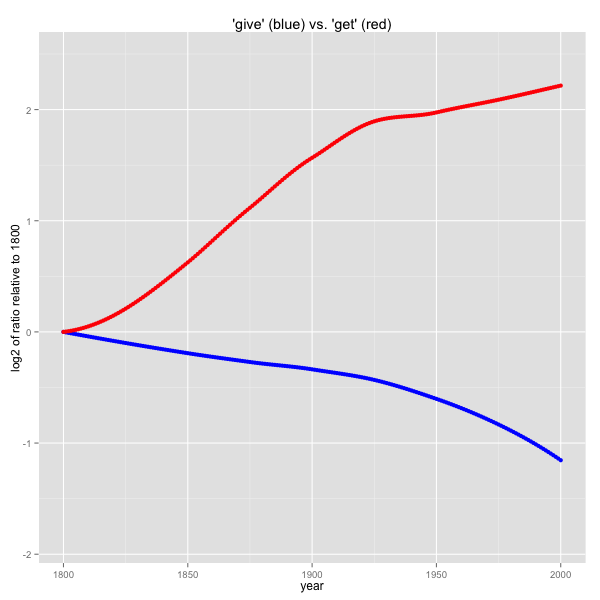 |
We could similarly match Greenfield's "act" vs. "feel" with "activity" vs. "passion":
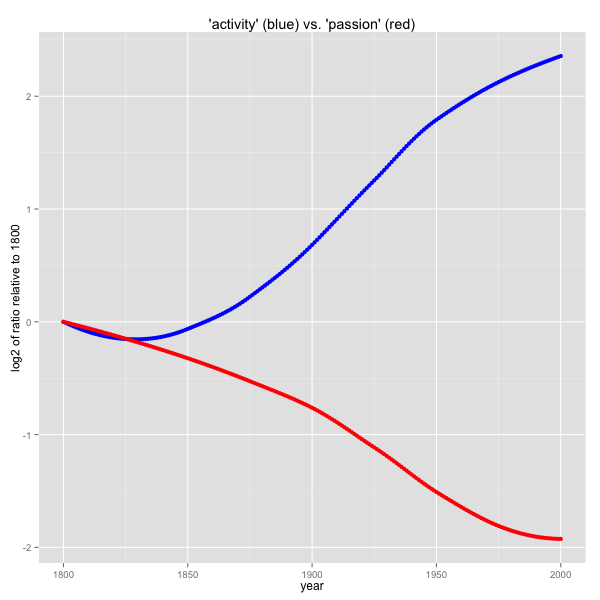 |
 |
And we could counter her "obedience, authority, belong, pray" vs. "individual, self, unique, child" with "conform, boss, membership, invoke" vs. "singular, my, alone, youth".
 |
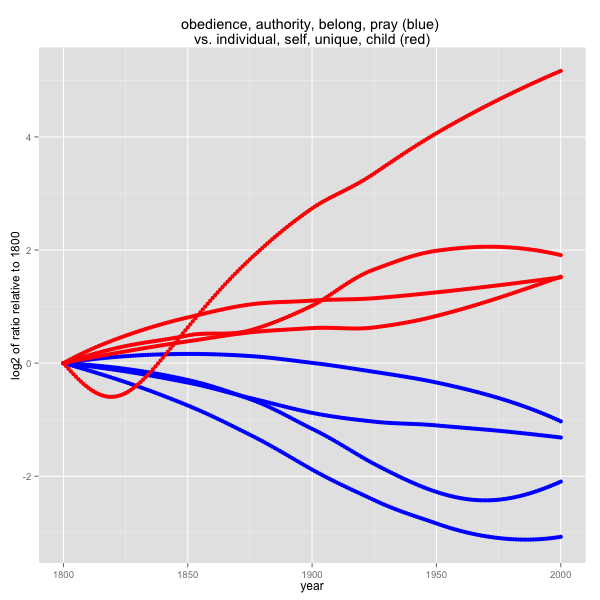 |
I'm not arguing that her theory is wrong, or that the Google ngrams datasets don't contain supporting evidence. But it's going to take a much more careful and systematic analysis of the lexico-historical data to convince me.
Will Equipping Police With Cameras Create Nicer Cops Or A Surveillance State?
Imagine thousands of new government–owned video cameras roaming the streets of New York City. Sounds like a huge leap towards a Big Brother state.
Surprisingly, civil liberties advocates are open to it. That's because the cameras would be worn by police, and could be used to document their bad behavior, whether that is brutality or improper stops and searches. More importantly, cops––like reality show stars and convenience store clerks––might behave differently if there's a video camera rolling.
Police departments around the country have been trying out the use of body–worn cameras.
From California and Arizona to Florida and Texas, some smaller police departments around the country have been trying out the use of body–worn cameras. But the NYPD is the nation's largest force, with 35,000 uniformed officers, and this week a federal judge ordered the department start a pilot program. The demand was tucked inside the judge's ruling that New York's controversial "stop–and–frisk" policy violates minorities' constitutional rights. The city bristled: Mayor Bloomberg told the Associated Press wearable cameras would be a "nightmare" for the NYPD, and some people wonder whether it would lead police to be too timid.
Experiments being undertaken around the country, however, are proving otherwise. In a full–year study with the police force in Rialto, California, that concluded in February of this year, researchers found that police used "force" half as many times as they had a year earlier when a tiny camera with a 12–hour battery life was worn on their shirt pocket, hat, collar or sunglasses. There were also only three complaints from the public during the study, compared to 28 complaints a year earlier.
"The study was able to expose what happens when the level of certainty of apprehension for professional misconduct was set at 100%. These are social circumstances that are characterized with an inescapable panopticonic gaze," the paper, co–authored by Rialto's police chief and University of Cambridge criminology researcher Barak Ariel.
Results like these, which were cited this week by the judge in the New York case, are why a number of civil liberties groups, including the New York Civil Liberties Union (NYCLU) and the Center for Constitutional Rights, cautiously endorse body–worn cameras for the NYPD––despite some concerns about privacy. NYCLU has already fought for police to record full interrogations (not just confessions), and body–worn cameras would be an extension of that, says associated legal director Chris Dunn. While no one wants to see the police taping the general public's activity, "we make a distinction," Dunn says, "when it is designed to curb and document police abuse."
No one knows yet how a pilot in New York City would take shape––for example, when exactly a camera would have to be turned on. If required to wear cameras, however, police officers might have an incentive to keep them running. By documenting the circumstances leading them to stop a person in the first place, they would be able to defend themselves against accusations of discrimination or improper use of force: "The more of it that's on tape, the better for them," said Dunn. Many police departments that use cameras like them as a defense against false accusations.
The more of it that's on tape, the better for them.
In theory, there would be strong privacy measures that restrict the use of the video unless there's a complaint, investigation or lawsuit––not, say, as evidence for a police officer having an affair with someone's wife, says Dunn. In Rialto, for example, the video collected wasn't supposed to be randomly reviewed.
But sanctioning law enforcement's use of body–worn cameras in one scenario could also lead down a slippery slope towards a stronger surveillance state. In fact, in most other situations, the NYCLU is quite concerned about the proliferation of surveillance cameras in public spaces––it sent a team to document 2,397 of them visible on the streets of Manhattan––and, given our recent history, privacy protections for policing cameras might not last in the face of pressure to use the tapes as evidence.
More importantly, the issues raised by these programs aren't restricted to the expensive, specialized cameras that police departments might purchase. Already, the public is documenting more and more on their phones––and if wearable computers like Google Glass take off, ubiquitous monitoring could simply become a fact of life.
The authors of the Rialto study imagine that other fields, such as the medical profession, might also reduce cases of "alleged unprofessional conduct" if doctors taped their interactions with patients. "We acknowledge that this may pose ethical considerations, though we believe that, on average, the benefits outweigh the costs," they write.
freeing resistance from civil disobedience
In the United States, discussion around bottom-up political activism has, for almost fifty years, been synonymous with discussion of civil disobedience. Civil disobedience has an almost theological role in US political activism. Writings on civil disobedience are canonical; particular interpretations of civil disobedience are simplified into pillars, commandments, and noble truths of activism; ambiguities of the cosmology are played out via the power struggles of sects; and deviations from doctrine are often considered anathema.
The history of political struggle in the United States is not the history of civil disobedience. From the Pullman strikes, to Colorado Labor Wars, to the Oakland General Strike of 1946, tactics not generally recognized as ‘civil disobedience’ have been on the front lines of protest. So when did civil disobedience gain its canonical role?
Different sources will trace the history of civil disobedience to various sources, from Ghandi’s doctrine of Satyagraha, to Thoreau’s titular essay, to Shelley’s poem The Mask of Anarchy in the wake of the Peterloo Massacre, to the Bible, and to Sophocles’ play Antigone. But in the United States, any discussion of grassroots activism will inevitably find its way to Martin Luther King Jr. and the Civil Rights Movement—the US kernel of activist authenticity.
 The Civil Rights Movement earns this authenticity for a variety of reasons. Perhaps primarily, contemporary readings of history consider the cause all but inviolate. Only the most marginal and disreputable commentators would say that the Civil Rights Movement was wrong for fighting the racist laws in many areas of the country. Second, the Civil Rights Movement is largely viewed to have won its struggle, culminating in the Civil Rights Act of 1964 and the Voting Rights Act of 1965 (the latter only recently gutted by a Supreme Court decision). And third, the Movement has a singular champion of civil disobedience in Martin Luther King Jr. Although he was hardly the sole leader of the movement, his admirable writings and speeches, and his assassination during the height of the struggle has made him stand out in historical accounts, and his recognition alone makes him a symbol within a particular understanding of how the Civil Rights Movement accomplished what it did.
The Civil Rights Movement earns this authenticity for a variety of reasons. Perhaps primarily, contemporary readings of history consider the cause all but inviolate. Only the most marginal and disreputable commentators would say that the Civil Rights Movement was wrong for fighting the racist laws in many areas of the country. Second, the Civil Rights Movement is largely viewed to have won its struggle, culminating in the Civil Rights Act of 1964 and the Voting Rights Act of 1965 (the latter only recently gutted by a Supreme Court decision). And third, the Movement has a singular champion of civil disobedience in Martin Luther King Jr. Although he was hardly the sole leader of the movement, his admirable writings and speeches, and his assassination during the height of the struggle has made him stand out in historical accounts, and his recognition alone makes him a symbol within a particular understanding of how the Civil Rights Movement accomplished what it did.
While the Civil Rights Movement is incredibly important to United States history, it is worth looking critically at how this focus shapes the understanding of civil disobedience and political activism. King’s Letter from a Birmingham Jail was written to justify a particular protest campaign of nonviolent resistance among his peers. King argued that what he and others were protesting was fundamentally unjust, and therefore they must resist. And one of the nonviolent means in which they resisted was civil disobedience, which King traced back to the Bible.
I hope you are able to see the distinction I am trying to point out. In no sense do I advocate evading or defying the law, as would the rabid segregationist. That would lead to anarchy. One who breaks an unjust law must do so openly, lovingly, and with a willingness to accept the penalty. I submit that an individual who breaks a law that conscience tells her is unjust, and willingly accepts the penalty of imprisonment in order to arouse the conscience of the community over its injustice, is in reality expressing the highest respect for law.
However, when activists discuss the Letter today, they read King’s words as a blanket strategy, not as a tactic. King and the other Birmingham Campaign protesters were resisting the laws which legalized segregation and outlawed public protest and boycotts, as well as the general climate of racism and bigotry. In such a circumstance, resisting the Birmingham laws against protest become a fundamental component of protest. In response to and anticipation of protests, boycotts, picketting, and marches had all been declared illegal by the police. Therefore, the link between justice of the protest campaign and civil disobedience of the city laws that would disrupt that protest is implicit.
King only mentions civil disobedience in one paragraph of the letter. But he mentions nonviolent direct action throughout the entirety of the letter. Nonviolent direct action is a broader playbook of protest tactics than mere civil disobedience. Eugene Sharp, who has written a book detailing many strategies and tactics of nonviolent protest, lists 198 methods of nonviolent protest and persuasion, of which only two are civil disobedience. So why has political activism come to focus on civil disobedience in particular?
A legal regime will attempt to use every manner at its disposal to perpetuate itself, and therefore will make tactics of resisting it illegal, to the furthest extent possible. King argues that unjust laws must be resisted, even if one thinks the legal regime is just. This concept of living a just life regardless of the intervention of unjust authorities is the core motivation of his call to nonviolent resistance. But in a climate in which the legal regime makes arbitrary laws to stem protest, it means that all forms of resistance become civil disobedience. If an occupation is deemed illegal, occupying becomes civil disobedience. If a boycott is illegalized, it is suddenly civil disobedience. If a book is banned by law, printing, distributing, or reading the book is civil disobedience.
 While certainly, laws that prohibit resistance should be not be followed in a time of resistance, this legal climate begins to conflate the words of King in activist discourse. The moral imperative to nonviolent resistance transits to a moral imperative to civil disobedience. This is problematic, because while a sense of justice as the backbone of a wide strategy of resistance is a major component of a generalized humanity, linking that sense of justice to a tactic of breaking laws is a recent development that has negative effects for bottom-up activism. The presence of injustice is a good reason to resist, but the presence of injustice is not necessarily a good compulsion to engage in civil disobedience. A strategy of resistance may declare itself in general beyond the legal regime, but any tactical activity in resistance must be chosen more carefully.
While certainly, laws that prohibit resistance should be not be followed in a time of resistance, this legal climate begins to conflate the words of King in activist discourse. The moral imperative to nonviolent resistance transits to a moral imperative to civil disobedience. This is problematic, because while a sense of justice as the backbone of a wide strategy of resistance is a major component of a generalized humanity, linking that sense of justice to a tactic of breaking laws is a recent development that has negative effects for bottom-up activism. The presence of injustice is a good reason to resist, but the presence of injustice is not necessarily a good compulsion to engage in civil disobedience. A strategy of resistance may declare itself in general beyond the legal regime, but any tactical activity in resistance must be chosen more carefully.
Laws will most certainly be broken in the course of resistance. But breaking laws is not the point—resistance is the point. Given the nonviolent precepts and religious tenor of moral resistance and submission in King and others’ writing and actions, and the ravenous extent of the legal system in the United States, civil disobedience in practice becomes shorthand for ‘get arrested.’ Civil disobedience, and all nonviolent resistance, becomes a categorical submission to arrest in practice—alert police laws will be broken, show up at place to break laws, and when all is ready, begin to violate the law and immediately offer oneself up to the police as they step into make arrests. Engaging in this dance with the police is considered to be upping the moral intensity of one’s protest, and engaging in just action. However, the crime for which one is arrested is never mentioned. Crossing an arbitrary line on a military base to be arrested by guards waiting for just this specific task is, in this liturgical practice, just as much a resistance as removing the train tracks that transport war materiel from that military base under the cover of night. A law is broken, one is arrested, therefore one’s activism is just. But what is never mentioned is that the penalty for sabotaging railroad tracks is far more significant than that of trespassing, because of course, the former would actually be a great imposition to the operation of a military base, whereas the latter is hardly an inconvenience. Trespassing is a minor offense, and often after the arrest such charges are dropped. The risk to the resister is minimal, as is the resistance. But as long as some law is broken, the activists can consider their actions to be just and nonviolent resistance is considered to have occurred.
Given the legal system in the United States which makes advocation of any particular crime in itself an offense, we can dispense with the hypothetical examples of what crimes might be more political expedient to resistance (this author certainly takes the threat of the legal regime seriously), and discuss the simple notion of submitting to arrest. Edward Snowden, the NSA leaker who is currently seeking political asylum after breaking laws by publicizing classified information, has been encouraged via editorials to come back to the United States to ‘justify’ his actions in the inevitable trial that would result from his arrest. If his resistance is real, he should be prepared to face jail time. This represents the most inane contortion of nonviolent resistance, by allowing the legal regime that is being resisted to define who is truly resisting. By evading arrest, Snowden is less of a resistor than if he was facing prison for the rest of his life, as the leaker Bradley Manning is.
 The notions of civil disobedience and legalities have become so central to theories of political activism in the United States, that the moral rectitude espoused by Martin Luther King Jr. and others has been rewritten as a desire for Christian martyrdom. Activism is only activism, it is argued, if all activists end up behind bars. The legal regime has so fully interpolated nonviolent resistance into its laws and the culture of those laws, that whether one submits to that authority has become the ultimate arbiter of whether one’s resistance against that authority is just.
The notions of civil disobedience and legalities have become so central to theories of political activism in the United States, that the moral rectitude espoused by Martin Luther King Jr. and others has been rewritten as a desire for Christian martyrdom. Activism is only activism, it is argued, if all activists end up behind bars. The legal regime has so fully interpolated nonviolent resistance into its laws and the culture of those laws, that whether one submits to that authority has become the ultimate arbiter of whether one’s resistance against that authority is just.
At what point will the runaway legal regime become so nefarious that we might see resistance not only as a violation of statutes, but a long term resistance to the system itself? When will nonviolent resistance be redeemed from this twisted reading of Letter from Birmingham Jail, so that one might resist in a manner that allows continued, successful resistance, rather than simply submission to authority? In the broader mindset of activism in the United States, I predict that the answer is: never. Despite the fact that the legal regime has learned to adapt to the tactics of the Civil Rights Movement in the last half century and is now better equipped to make civil disobedience ineffectual. Activist culture in the United States depends on the theological centrality of civil disobedience to justify its own existence and understand itself within history. Re-interpreting this history in the context of the contemporary legal regime is possible, but it is also hard work, and is in itself being illegalized at every turn. Unfortunately, the moral imperative to resist has been satiated by martyrdom, and the risks of redefining this resistance away this revisionist civil disobedience strategy are great.
Cops in High Stop-and-Frisk Precincts Will Wear Cameras Under New Ruling

A detail that we (and others) neglected to report when yesterday’s “stop-and-frisk is unconstitutional” ruling came in: police in the precinct with the highest number of stops in each borough will be required to wear cameras for a one-year pilot program, in an effort to bring more objective evidence around the tactic.
“The recordings may either confirm or refute the belief of some minorities that they have been stopped simply as a result of their race, or based on the clothes they wore, such as baggy pants or a hoodie,” Scheindlin wrote in her ruling.
The cameras could also curtail police use of force, according to the findings of a similar pilot program in Rialto, California, DNAinfo reports. In Rialto–a town the size of one NYPD precinct–a study found that cameras brought civilian complaints about police to 17 from 24 in a similar period without cameras.
Mayor Bloomberg, who plans to appeal the decision, isn’t happy about the cameras. “It would be a nightmare,” he said. “A camera on a [cop’s] lapel — he turned the right way, he didn’t turn the right way — it’s not a solution to the problem.”
The post Cops in High Stop-and-Frisk Precincts Will Wear Cameras Under New Ruling appeared first on ANIMAL.
Kingdom/Order – Part 1- by Reid Psaltis
Interrogation of NSA Recruiters By Students Is Perfect Internet Age Protest
I had a very minor argument today after I’d announced that I would not be attending any anti-surveillance demonstrations planned for tomorrow. Since Occupy, I have pretty much sworn off traditional placards and chants protests, on the grounds that, in the absence of any real mass support, they become masochistic rituals of powerlessness and capitulation. If you want to feel marginal and disempowered, stand in the middle of Times Square with about one hundred other people with placards, watching tourists being amused by you, while the fake sunshine of gazillion watt advertising shines off their faces. This may not be the right way to feel — perhaps the powers find this stuff more dangerous than it looks on the surface — but it’s the way I do at these things and why I’m done with them for the time being.
In light of doing more thinking about this than usual today, I was delighted to discover this wonderful Soundcloud of students interrogating NSA recruiters at the University of Wisconsin. This, to me, is exactly the right kind of peaceful protest at this particular stage in opposition to surveillance and a perfect demonstration of leveraging the internet when numbers aren’t on your side. The full story is written up on The Huffington Post. In a nutshell, some really smart students relentlessly interrogated NSA representatives about what the NSA does and the ways in which the flacks have misrepresented that during the recruiting session. There is quite a lot to love here: the students doing the interrogating — I only know the name of one, Madiha Tahir — are marvelously well-informed, eloquent, relentless and calm and they make the government’s representatives look like lying fools. The result is educational, empowering, revealing and genuinely disruptive in all the ways public protest should be but too rarely is.
I am not inviting either/or-ing here. All forms of protest are better than nothing. But, to me, this is really how to do it now.
Kelvin Helmholtz Clouds
Kelvin-Helmholtz clouds resemble waves breaking in the ocean. These clouds are formed between two layers of air with different densities and traveling at different speeds. If a warm, less dense layer of air exists over a layer of colder, denser air, and the wind shear across the two layers is strong enough, eddies will develop along the boundary. Evaporation and condensation of the eddies render them visible as wave shaped clouds.
The cloud is named after Lord Kelvin and Hermann von Helmholtz who studied the dynamics of two fluids of different densities when a small disturbance, such as a wave, was introduced at the boundary connecting the fluids. The Kelvin–Helmholtz instability occurs not only in clouds but also in the ocean, Saturn's bands, Jupiter's Red Spot, and the sun's corona.












Also see:
- Punch Hole Clouds
- Clouds That Look Like Things
- Fire Rainbows: A Rare Cloud Phenomenon
- Mysterious Morning Glory Cloud Formation
- Fantastic Condo Wave Cloud Hits Florida Coast
The human cost of Detroit’s petroleum Koch piles
Made in Detroit, owned by the Koch Brothers and burned in Michigan.
Much has been written recently about the mysterious black piles that appeared in one day in November 2012 on the banks of the Detroit River, not far from the Motor City’s downtown district, right next to the Ambassador Bridge – the busiest international crossing in North America. These huge stockpiles of petroleum coke, the byproduct of refining tar sands oil at the Marathon refinery in Southwest Detroit, are owned by Koch Carbon, a company run by the brothers Charles and David Koch.
Debate about possible health and environmental concerns, as well as permit and storage issues have been widely reported in the press both in the US and across the river in Windsor, Canada. Citizen and environmental groups are calling for action, while US Congressman Gary Peters (D-Mich) introduced the Petroleum Transparency and Public Health Study Act in Washington on June 6, 2013 that calls for an investigation into the piles and seeks information on how Michigan residents are affected by them.
This series of photographs takes a closer look at the people the petroleum coke piles are impacting, the areas around the stockpiles and where it is being produced.

McKenzie Duke looks out the window onto the three story piles of petroleum coke accumulating across the street from the building she lives in. Duke, an attorney and counselor in Detroit, moved into The Hudson lofts building on Fort street in August 2012. In November that same year, piles of petroleum coke, the byproduct of refining tar sands crude from Alberta, appeared and started growing across the street. During the past 6-8 weeks since the weather has been warmer, she has had her windows open and says she has been feeling poorly. Her face has broken out in a severe rash and her doctor has been unable to find out what could be causing it.

Piles of petroleum coke, or pet coke, stored close to the city center along the Detroit River just east of the Ambassador Bridge, the busiest international crossing in North America. The material is produced at the Marathon Petroleum refinery in Southwest Detroit and has been purchased by Koch Carbon, a company run by the brothers David and Charles Koch. Detroit Bulk Storage is managing the stockpiles on industrial property leased from Ambassador Bridge owner Matty Moroun, with transportation from the refinery provided by Savage Industries of Melvindale, Michigan.
In response to questions about storage along the river, Paul Baltzer Director of Communication for Koch Companies wrote in an email statement, “Koch Carbon owns the petroleum coke currently being stored and shipped from a facility operated by Detroit Bulk Storage. Under our contract, the material is to be stored and handled in a safe and compliant manner, in accordance with all applicable city, state and federal requirements.”
With additional concerns about permits being granted for the storage of this type of material along the river, Daniel Cherrin, spokesperson for Detroit Bulk Storage said in a written statement, “An application for a permit to store the pet coke in its current location has been submitted to the City of Detroit for review. A variance has also been requested. Detroit Bulk continues to work with government officials, ensuring full compliance.”

With local residents, business owners and Canadians across the river in Windsor, concerned about potential and environmental risks resulting from the uncovered stockpiles, U.S. Congress man Gary Peters (D-Mich) holds a press conference on May 28th, 2013 to raise new concerns about pet coke stored along the river.
With the black coal-like mounds visible behind him, Peters told reporters, ”This material is basically dirtier than the dirtiest coal.” He added, “Michiganders deserve answers for why pet coke is allowed to be stored in open air, near the Detroit River and our community, and whether this is being stored with proper permits.” The following week Peters introduced the Petroleum Transparency and Public Health Study Act in Washington.

Fishermen on the Detroit River troll by Koch Carbon’s mountains of pet coke on an early Sunday morning. When asked, many who fish the river say they are not concerned about potential hazards like runoff or dust from the piles on them, the fish in the river or the Great Lakes watershed. The city’s much-photographed abandoned train station, Michigan Central Station, sits only a few blocks away, while storm drains that run under the site can be seen running into the river.

Petroleum coke resembles large grains of sand and is slightly sticky to the touch. Its high heat and low ash content make it attractive for burning in coal-fired power plants but it is high in sulfur thus, to comply with current North American emissions standards, some form of sulfur capture is required.

Media continue to shy-away from reporting petroleum coke that is churning out of the Marathon refinery in SW Detroit is in fact being burned at the DTE Monroe coal plant just downriver from the piles.
Current news reports have stated that pet coke from the Marathon refinery is being sold mostly for use in overseas markets like China and India where it will be burned as fuel. However, DTE Energy spokesperson Randi Berris has confirmed that the power company did use pet coke from the Detroit refinery in tests at their Monroe coal plant downriver in February and March of this year.
The Michigan Department of Natural Resources and Environment granted DTE an air permit in late 2010, just before new stricter federal regulations came into effect to burn the material. The permit allows DTE to burn 10-12% pet coke in its fuel mix at the facility according to Berris.
Randi Berris, spokesperson for DTE Energy confirmed in a phone conversation that the plant has burned petroleum coke during tests in August 2012, February and March 2013. A total of 13,500 tons of pet coke was used over the three months. She said the Marathon refinery in SW Detroit supplied the pet coke for the February and March tests, with 500 tons – 10 truck-loads – coming directly from the controversial piles along the river upstream in Detroit. Pet coke for the August 2012 tests came from Louisiana according to Berris.
She added that with the controversy surrounding the Koch-owned stockpiles along the Detroit river, DTE decided against getting its supply from that location in the future because they, as she put it, “want to be good corporate citizens.” She said that if DTE decides to burn petroleum coke in the future, and they choose the Marathon refinery to get it from, they will secure supplies directly from the refinery, not an outside supplier.

The petroleum coke stored along the river is produced here at the Marathon Petroleum refinery in Southwest Detroit. Located in an economically distressed area of the city, home to the most polluted ZIP code – 48217 – in Michigan, Marathon put $2.2 billion dollars into refitting and expanding the refinery to handle the large flow of tar sands crude coming from Alberta transported via the Enbridge pipeline.
This expansion has encroached even further on the already crumbling neighborhood of Oakwood Heights bordering it. Marathon has offered buyouts to some homeowners so they can relocate in effort to create a ‘buffer zone’ around the refinery, while holding out on others.

Sherry Griswold has lived here for over 20 years. The expansion of the refinery has not only brought the section that produces the pet coke right up to the boarder of her lot, she says it has created a nightmare of explosions and chemical releases that have severely damaged her health.
According to Sherry, a recent incident on May 21, 2013, exposed her to an overwhelming dose of chemicals, “I walked outside and the whole ground was shaking.” She described. “I called on them finally at seven o’clock, it started at one, I couldn’t handle it no more, I couldn’t handle the noise, I had nowhere to go.”
She called Marathon and they shut it down immediately. “That’s when they gassed me through the front window,” she said.
The following morning she woke up smelling gas with her skin and eyes burning. Her doctor advised her to get to the Emergency Room where they x-rayed her lungs to check for inhalation of chemicals and treated burns to her arms and face.
Sherry added that on May 29, her doctor informed her during a check-up that tests have shown her brain has been injured from exposure to chemicals and that he has referred her to The Michigan Institute for Neurological Disorders, MIND for treatment.

Rhonda Anderson (left), Organizing Representative for the Sierra Club’s Environmental Justice Program, talks with Sherry during a recent visit to Sherry’s home. Rhonda has been helping her since 2010 in her fight against Marathon refinery.
Since Governor Rick Snyder has been in office Rhonda feels nothing with regards to environmental justice has been done for citizens of the community. Speaking on industry and environmental justice she says, “They run, they can’t stand it, cause they think it’s gonna cost them some money.”
“But then what’s the cost to the community? Whose cost is the most important?” She adds, “Right now, residents are on the losing end.”

Sherry keeps careful track of the incidents she witnesses in her home coming from the refinery next door and each call she makes to report it. This is her list from May detailing dates, times and incident numbers given to her by Marathon.

The Marathon refinery can be seen from just about every angle in Sherry’s neighborhood. Rhonda Anderson says that communities like these are the sacrifice zones. When addressing environmental justice, she first looks at communities of color, and low income communities because this is where industry most often sets up shop.
“This is what’s happening to Sherry, this is what’s happening to this entire community,” Rhonda explains.

Marathon Petroleum has purchased and demolished a number of homes in the neighborhood bordering the refinery, offering buyouts for some home owners and renters, to create a ‘buffer zone’ around the facility.
Some residents here have hired real estate agents to help sell their homes instead of taking a buyout, hoping for a better offer from Marathon. Others like Sherry Griswold and her friend and landlord Tom Gutenschwager, who owns a welding business across the street from her, were offered nothing even though they are the closest property to the refinery.
“They’re trying to smoke us out,” Sherry says.

The neighborhood next to the refinery has a surreal air about it. Buildings purchased by Marathon are boarded up and locked with TV satellite dishes and Christmas lights still attached. These sit next to vacant lots and homes with families living in them while other houses across the street are burned-out and strewn with litter.
![Just down the street from Sherry Griswold Robert Parmenter sits on his front porch. He has lived in the neighborhood for 20 years and rents the house. “I’m ready to go,” he says, “As soon as [the landlord] sells the house, I’d be out the same day.” Marathon did not offer him a buyout to leave. When asked if he has experienced any health problems from living next to the refinery, he replies, “Except breathing?” He adds that Marathon has ruined the entire area, “This neighborhood ain’t no good man.”](http://www.stillscenes.com/wp-content/uploads/2013/06/detroit_petcoke_fassinger_14.jpg)
Just down the street from Sherry Griswold, Robert Parmenter sits on his front porch. He has lived in the neighborhood for 20 years and rents the place. Marathon did not offer him a buyout to leave. “I’m ready to go,” he says. “As soon as [the landlord] sells the house, I’d be out the same day.”
He adds, “This neighborhood ain’t no good man,” and says Marathon has ruined the entire area. When asked about any health problems he has from living next to the refinery, he replies, “You mean except breathing?”

Residential neighborhoods surround the Marathon refinery. These homes in Melvindale, on the other side of the refinery from Oakwood Heights also back up to the facility.

Sam Rosado has lived in the industrial area of Southwest Detroit for 16 years. Fishing on the shore across from the piles of petroleum coke and coal on Zug Island, not far from the Marathon refinery and home to United States Steel, he says he won’t eat the fish he catches and does it just for fun.
Casting out his line he adds, “I pulled some fish out of here and they don’t look right.”

Sam says of his catch across from Zug Island, “If I get something big enough I give it away to some people I know.”

Back upriver, in a fishing area next to the controversial stockpiles of pet coke owned by Koch Carbon, Lawrence Jackson pulls a Silver Bass out of the river. He doesn’t worry too much about contamination he says.

The General Motors Renaissance Center, world headquarters of the Detroit auto giant, looms in the background of the stockpiles of pet coke along the river. According to Detroit Bulk Storage, the company in charge of storing and managing the material at this site, six acres of asphalt has been put down under the piles to direct any runoff water away from the Detroit River and towards the center of the pad in compliance with DEQ guidelines. They claim the asphalt also provides an impermeable barrier between the pet coke and the ground soil.

A vacuum and water truck are stationed at the site and according to Detroit Bulk Storage, used to help keep dust levels down. In a statement from the company, spokesperson Daniel Cherrin writes, “Detroit Bulk continuously sprays the roadways and the active piles of pet coke with water from a 3000 gallon tanker truck to minimize fugitive dust in the air, water or land around the property.”
Cherrin adds, “Detroit Bulk sprays the piles with an encrusting agent similar to an epoxy seal on non-active piles to trap fugitive dust and the absence of a traditional canvas or tarp on the piles, does not indicate that the piles have not been sealed in order to prevent the emission of dust particles. Detroit Bulk has a vacuum truck on the property which is used as needed to conform to the Fugitive Dust Plan submitted to the DEQ.”

From the picnic tables outside the Green Dot Stables restaurant on West Lafayette, the black piles of pet coke along the river are clearly visible and only a block away. At first, owner Jacques Driscoll was a bit disappointed that the three story piles blocked his customers’ international view across the river to Canada, but later began to be concerned about other issues that might arise from the uncovered piles being stored so close.

Jacques is now worried about the pet coke and what storing it out in the open might do to him, his family, his employees and his customers. He and his wife live close by and he wishes someone would come out with a definitive answer if it is harmful or not.
“I don’t want to be a whistleblower or anything like that, I just want to know,” he says. “Not knowing is the hardest part.”
“Let’s say that it is fine, but it has a minimal health affect, what if I live here for the next 30 years, I’m still exposed to it. What about the other people that live here? Do you want to have that in the back of your mind every time you open a window?”

Jacques started the Green Dot Stables restaurant with his wife Christine just over a year ago. They are part of a growing number of young entrepreneurs who have set up business in Detroit not only take advantage of opportunity as the city struggles to recover from economic crisis, but to contribute its comeback and be a part of the community.
Talking about the uncovered pet coke sitting just a block away he says, “It’s pretty ballsy to put something on the river knowing that it’s bad, if it truly is bad, and try to get away with it.”

A Canadian view of the stockpiles along the river the city shares with Detroit. Here in Windsor, Canadians not only look out onto the pet coke piles each day but complain of the large amounts of dust and particulate matter in the air that blows over the river onto their city. Many are sounding alarm bells about the potential health and environmental issues of storing the piles out in the open.

Dan Germain looks out the eighth floor windows of the high-rise condo he shares with his wife Ruth and their daughter across the river from Detroit in Windsor. The family relocated from just outside Toronto three years ago and after moving into their new condominium at Portofino Riverside Towers along the river, were impressed with the view they had of the Detroit skyline.
But that changed after the piles of Petroleum coke appeared in November 2012. Dan’s wife, Ruth Gemain, wrote letters about the pet coke piles to the city and provincial governments but she says, “Ontario has been quiet about it.”
Fed up with the dust, worried about potential health risks, and tired of waiting for the government to step in, Ruth started the Facebook page, Petroleum Coke Awareness Detroit, in March 2013 to raise awareness about the issue. With little information about the production and use of petroleum coke, she started researching, connecting with others and putting up her findings on the page.
The Windsor Star was one of the first newspapers to write about the piles she says, well before the Detroit Press ever took notice. She cannot understand why there is no US law mandating the piles be covered.
“We shouldn’t be reinventing the wheel here,” she says, “since one already exists in California that regulates that state’s petroleum coke storage.” She adds that people across the river in Detroit don’t realize, “What impacts you, impacts us.”

People enjoy a Sunday morning fishing on the Windsor shore. Across the river, not far from the Ambassador Bridge and the controversial piles of pet coke, Detroit Bulk Storage manages another site, seen here, at the Nicholson Docks where the material is also being stored and loaded onto freighters.
![Back in Detroit, the debate heats up over the pet coke piles and with legislation slated to be introduced this week in Washington to deal with the issue, local residents and businesses on both sides of the river are waiting for answers. Daniel Cherrin, spokesperson from Detroit Bulk Storage welcomes the opportunity to talk with others about the precautions being taken to ensure the health and safety of the community, “With the shipping season underway, empty vessels will appear at the docks every two weeks or sooner to be loaded with pet coke which will result in smaller stockpiles along the river. The community concerns about their health and safety while the petroleum coke may be stockpiled outside awaiting transport are understandable.” Windsor resident Ruth Germain puts it this way, referring to the entire process of extracting, transporting, refining and burning crude from the Alberta oil sands, “[People] need to realize it’s not just the piles and there is much more to it.”](http://www.stillscenes.com/wp-content/uploads/2013/06/detroit_petcoke_fassinger_27.jpg)
Back in Detroit, the debate heats up over the pet coke piles and with the Petroleum Transparency and Public Health Study Act introduced in Washington to deal with the issue, local residents and businesses on both sides of the river are waiting for answers.
Daniel Cherrin, spokesperson from Detroit Bulk Storage welcomes the opportunity to talk with others about the precautions being taken to ensure the health and safety of the community, “With the shipping season underway, empty vessels will appear at the docks every two weeks or sooner to be loaded with pet coke which will result in smaller stockpiles along the river. The community concerns about their health and safety while the petroleum coke may be stockpiled outside awaiting transport are understandable.”
Windsor resident Ruth Germain puts it this way, referring to the entire process of extracting, transporting, refining and burning crude from the Alberta oil sands, “[People] need to realize it’s not just the piles and there is much more to it.”
Originally photographed for the Guardian UK and published on June 7, 2013
And also here in an additional story which accompanied it on the same day
Obama’s Dirty War on Journalism
Out of all the harrowing storylines in journalist Jeremy Scahill's new film Dirty Wars, the one about Abdulelah Haider Shaye best spotlights the U.S. government's new assault against press freedom.
Shaye is the Yemeni journalist who in 2009 exposed his government's coverup of a U.S. missile strike that, according to McClatchy’s newswire, ended up killing "dozens of civilians, including 14 women and 21 children." McClatchy notes that for the supposed crime of committing journalism, Shaye was sentenced to five years in prison following a trial that "was widely condemned as a sham" by watchdog groups and experts who noted that the prosecution did not "offer any substantive evidence to support [its] charges."
What, you might ask, does this have to do with the American government's attitude toward press freedom? That's where Scahill's movie comes in. As the film shows, when international pressure moved the Yemeni government to finally consider pardoning Shaye, President Obama personally intervened, using a phone call with Yemen's leader to halt the journalist's release.
Had this been an isolated incident, it might be easy to write off. But the president's move to criminalize the reporting of inconvenient facts is sadly emblematic of his administration's larger war against journalism. And, mind you, the word "war" is no overstatement.
As New York Times media correspondent David Carr put it: "If you add up the pulling of news organization phone records (The Associated Press), the tracking of individual reporters (Fox News), and the effort by the current administration to go after sources (seven instances and counting in which a government official has been criminally charged with leaking classified information to the news media), suggesting that there is a war on the press is less hyperbole than simple math."
In this unprecedented global war, President Obama has been backed by the combined power of Justice Department prosecutors, FBI surveillance agents, State Department diplomats and, perhaps most troubling of all, a cadre of high-profile Benedict Arnolds within the media itself.
One of them is Meet the Press host David Gregory, who, after saying journalist Glenn Greenwald "aided and abetted" NSA whistleblower Edward Snowden, demanded to know of the reporter: "Why shouldn’t you be charged with a crime?" On the same Meet the Press program, NBC's Chuck Todd didn't want to know whether the NSA's surveillance is illegal, but instead demanded to know "how much was (Greenwald) involved in the plot" to expose the NSA's potential crimes. They were subsequently followed up by New York Times business reporter Andrew Ross Sorkin, who, after years of writing hagiography that helped Wall Streeters avoid prosecution, called for Greenwald's arrest.
Not surprisingly, the result of all this is a culture of fear. As the CEO of the Associated Press recently said, there has been a "chilling effect on newsgathering" thanks to an assault which seems "tailor-made to comfort authoritarian regimes that want to suppress their own news media."
By definition, the consequences of that "chilling effect" will be difficult to see - stories never reported, facts never unearthed and whistles never blown. In cases like Shaye's, there will also be journalists not released from prison.
No doubt, the resulting news vacuum is exactly what the Obama administration wants. After all, even if the White House's version of events is wildly inaccurate, deliberately misleading or completely untrue, such a vacuum allows the official story to become the only story.
That kind of information monopoly is great for the president, and it is perfectly acceptable to the courtiers and glorified television actors in the Washington press corps who masquerade as real journalists. But it is quite the opposite for a world that desperately needs more independent reporting and assumption-challenging journalism, not less.
Sean Hannity: Not even wrong, new report says
A report released by the Moral Philosophy Research Group this week confirms what many have long suspected: Sean Hannity’s commentary is entirely devoid of cognitive content. “Yes, except we mean it literally,” says Anthony Vega, the report’s lead author. “When Hannity utters a sentence, he’s not asserting a proposition that might be true or false – he’s simply expressing an attitude.”
The researchers first became interested in Hannity after noticing a startling contrast between his apparently successful use of language and what seemed to be a never-ending string of blatant falsehoods. “Most of what he says seems to be demonstrably false,” Vega notes, “and yet he engages in these back-and-forth exchanges in which his guests somehow just don’t seem to care. I found myself wondering: What if Sean Hannity isn’t even in the business of describing reality?”
The hypothesis turned out to yield remarkable success in interpreting many of Hannity’s otherwise puzzling statements, Vega says. Consider, for instance, Hannity’s repeated claim that America has the greatest health care system on Earth. “There’s just no plausible standard by which that could be true,” explains Vega. “What he’s really saying is: ‘USA! USA!’ It’s a little more obvious when he says things like: ‘The US is the greatest, best country God has ever given man on the face of the earth.’ This particular pro-attitude is a common theme for him.”
Hannity’s locutions often manifest the superficial grammatical and logical properties indicative of assertions, Vega continues, “which is probably why he’s typically interpreted as at least making an attempt at engaging in reasoned discourse. But don’t be fooled: his goal isn’t actually to describe some mind-independent realm of facts – much less to present others with reasons for believing his claims about those facts.” The full report, “A Non-Cognitive Analysis of Sean Hannity,” is available for download on the Moral Philosophy Research Group’s website.
[Speaking of assertion, I’ve just had a paper on assertion and epistemic regress accepted for publication in Thought. You can read the abstract and download the paper here.]
Today's Saying
It's not by me, and I don't know who invented it. But it's a beautiful political parable:
Americans are like mushrooms: Kept in the dark and fed with shit.
The System 656: Choose Muffins
So tonight got interesting. I got home and was following the #SB5 coverage in Texas (abortion laws, filibusters, etc.) and saw this tweet:
#ThisIsCNN pic.twitter.com/8MPRj2DvtW
— brownpau (@brownpau) June 26, 2013
So I posted this:
AP and CBS calling it passed. Twitter is calling it bullshit. CNN calling muffins fattening.
— One-Trick Studmuffin (@Rosscott) June 26, 2013
Clearly that got a little out of hand. (Thanks for sharing it, guys! Actually happened.) We’re all still figuring out what’s happening, but right now in this day and age I didn’t think to turn on my TV (which got paused on Netflix 4 hours ago and I never went back) I just turned to Twitter and Facebook. I’ve been watching the YouTube stream and now Christopher DiDo’s uStream ever since. I’ll update more in the morning or something.
Peter Drew ‘N Stuff
Peter Drew has been working on the theme of technology and the way it can flatten human emotions. Below are a few of our favorites. For more, check out his website here.
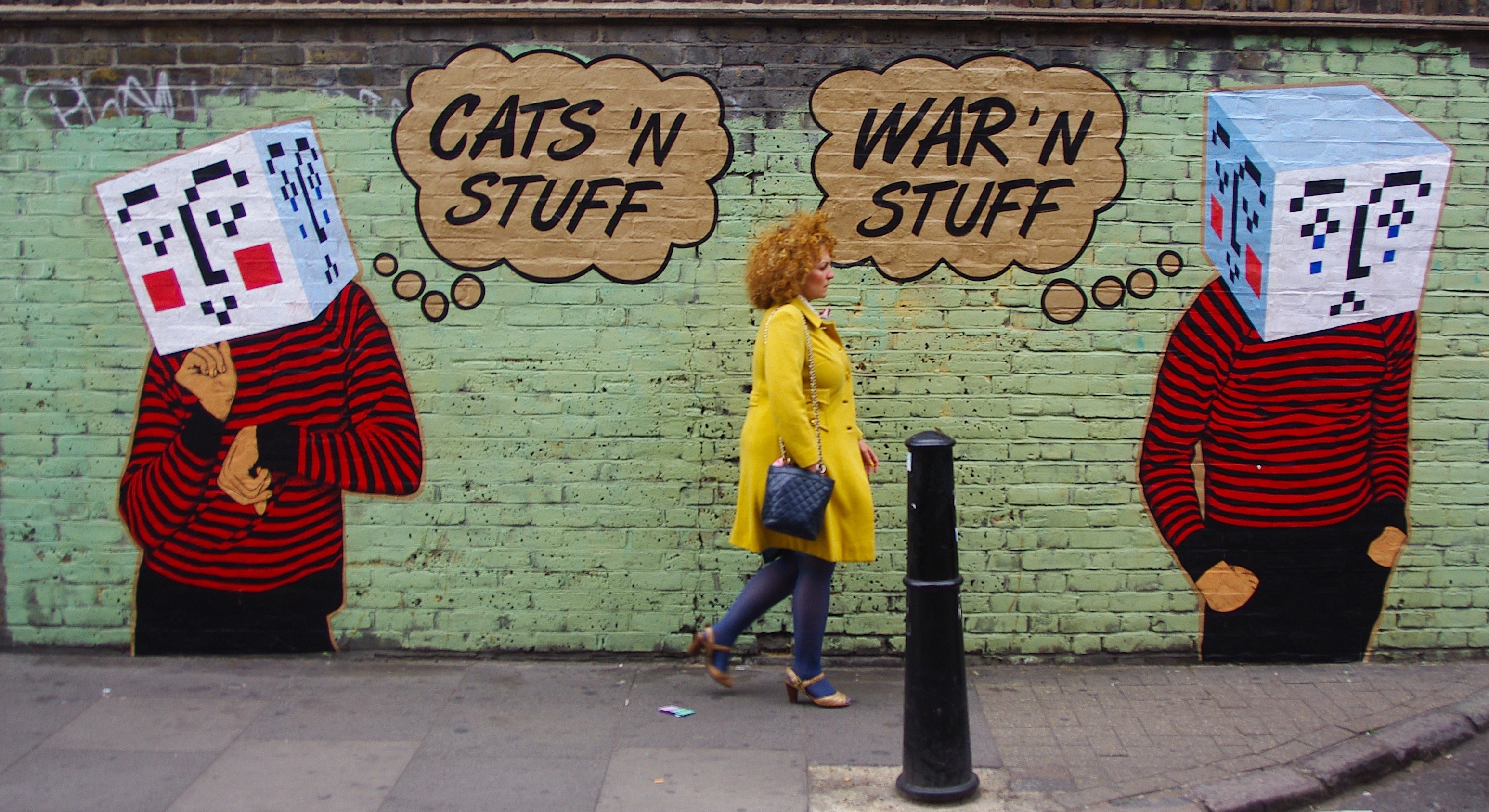
![]()


.jpg)

























